Managing Business Activities to Achieve Results - Report
VerifiedAdded on 2020/01/23
|18
|5896
|35
Report
AI Summary
This report provides a comprehensive analysis of managing business activities to achieve desired results. It begins by examining organizational structure, including the roles of key personnel like the President, consultants, and business development managers. The report then outlines the importance of process mapping, financial planning, recruitment, internal business processes, and employee development in achieving organizational goals. It further explores the use of a quality gateway to ensure the effectiveness of recruitment processes. The report delves into business planning, emphasizing the importance of defining mission and vision, conducting checklists, and assessing workforce potential. It then applies the SMART approach to define specific, measurable, achievable, relevant, and time-bound objectives. The report also touches upon organizational systems and the importance of setting attainable goals for employees. The report is a valuable resource for students seeking to understand and implement effective business management strategies and is available on Desklib, a platform offering AI-based study tools.
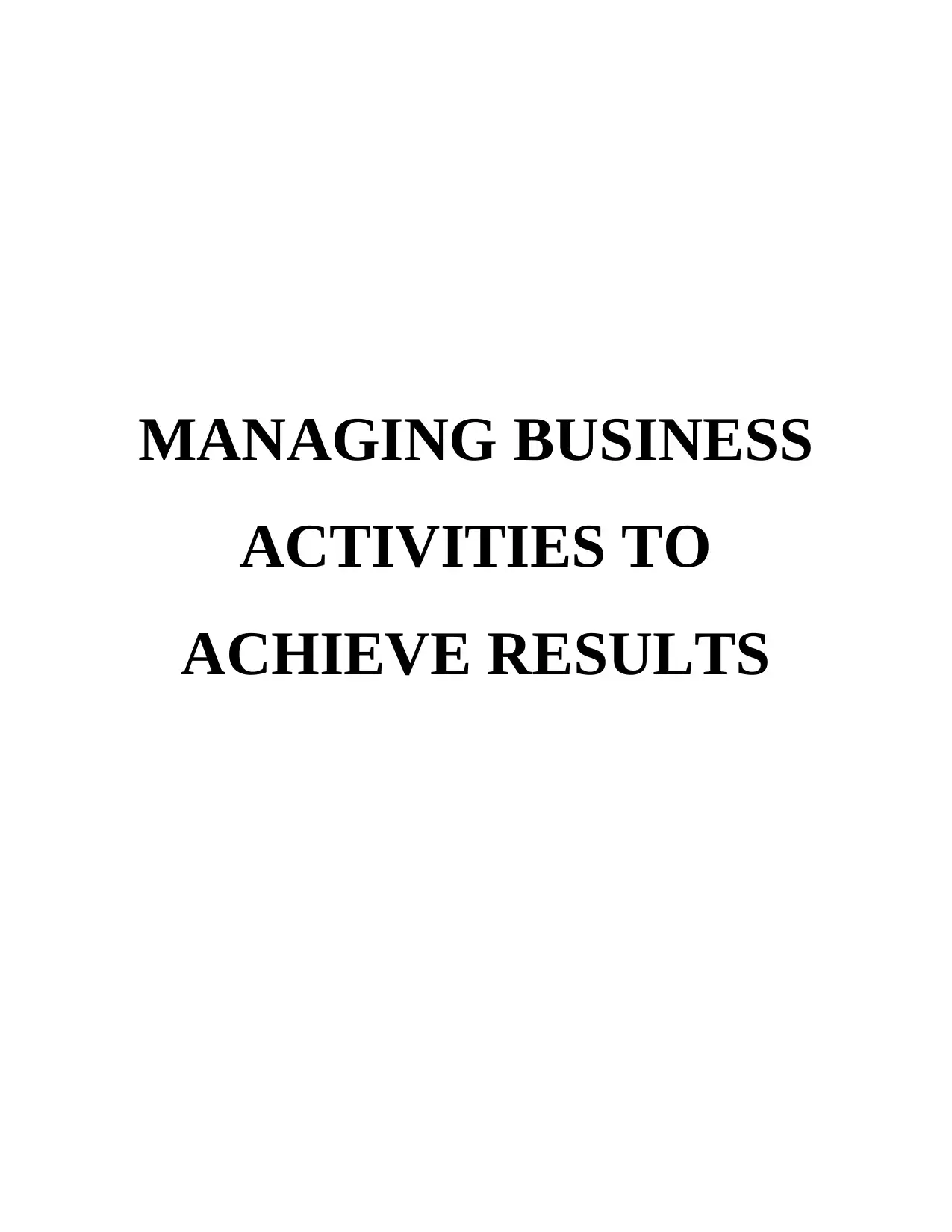
MANAGING BUSINESS
ACTIVITIES TO
ACHIEVE RESULTS
ACTIVITIES TO
ACHIEVE RESULTS
Secure Best Marks with AI Grader
Need help grading? Try our AI Grader for instant feedback on your assignments.
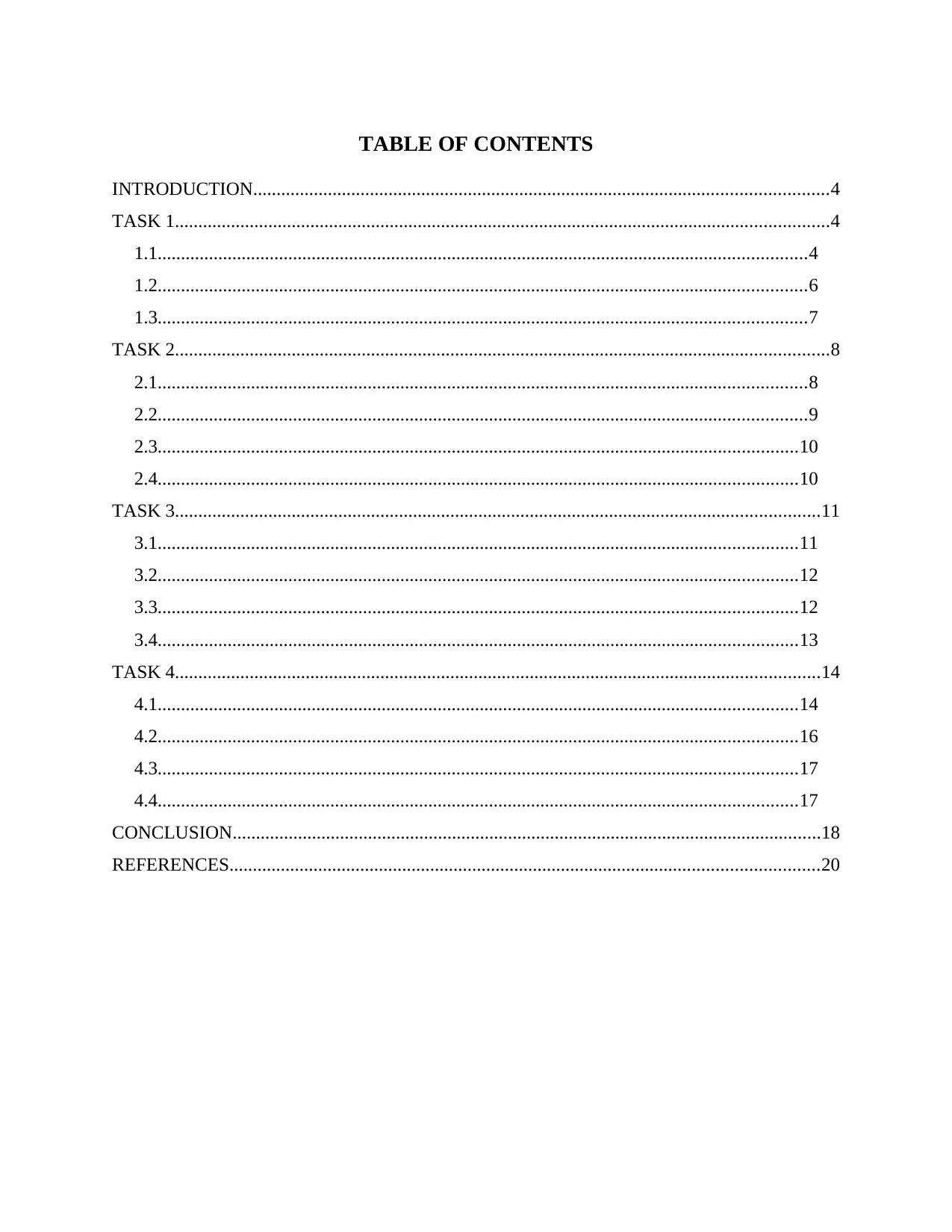
TABLE OF CONTENTS
INTRODUCTION...........................................................................................................................4
TASK 1............................................................................................................................................4
1.1...........................................................................................................................................4
1.2...........................................................................................................................................6
1.3...........................................................................................................................................7
TASK 2............................................................................................................................................8
2.1...........................................................................................................................................8
2.2...........................................................................................................................................9
2.3.........................................................................................................................................10
2.4.........................................................................................................................................10
TASK 3..........................................................................................................................................11
3.1.........................................................................................................................................11
3.2.........................................................................................................................................12
3.3.........................................................................................................................................12
3.4.........................................................................................................................................13
TASK 4..........................................................................................................................................14
4.1.........................................................................................................................................14
4.2.........................................................................................................................................16
4.3.........................................................................................................................................17
4.4.........................................................................................................................................17
CONCLUSION..............................................................................................................................18
REFERENCES..............................................................................................................................20
INTRODUCTION...........................................................................................................................4
TASK 1............................................................................................................................................4
1.1...........................................................................................................................................4
1.2...........................................................................................................................................6
1.3...........................................................................................................................................7
TASK 2............................................................................................................................................8
2.1...........................................................................................................................................8
2.2...........................................................................................................................................9
2.3.........................................................................................................................................10
2.4.........................................................................................................................................10
TASK 3..........................................................................................................................................11
3.1.........................................................................................................................................11
3.2.........................................................................................................................................12
3.3.........................................................................................................................................12
3.4.........................................................................................................................................13
TASK 4..........................................................................................................................................14
4.1.........................................................................................................................................14
4.2.........................................................................................................................................16
4.3.........................................................................................................................................17
4.4.........................................................................................................................................17
CONCLUSION..............................................................................................................................18
REFERENCES..............................................................................................................................20
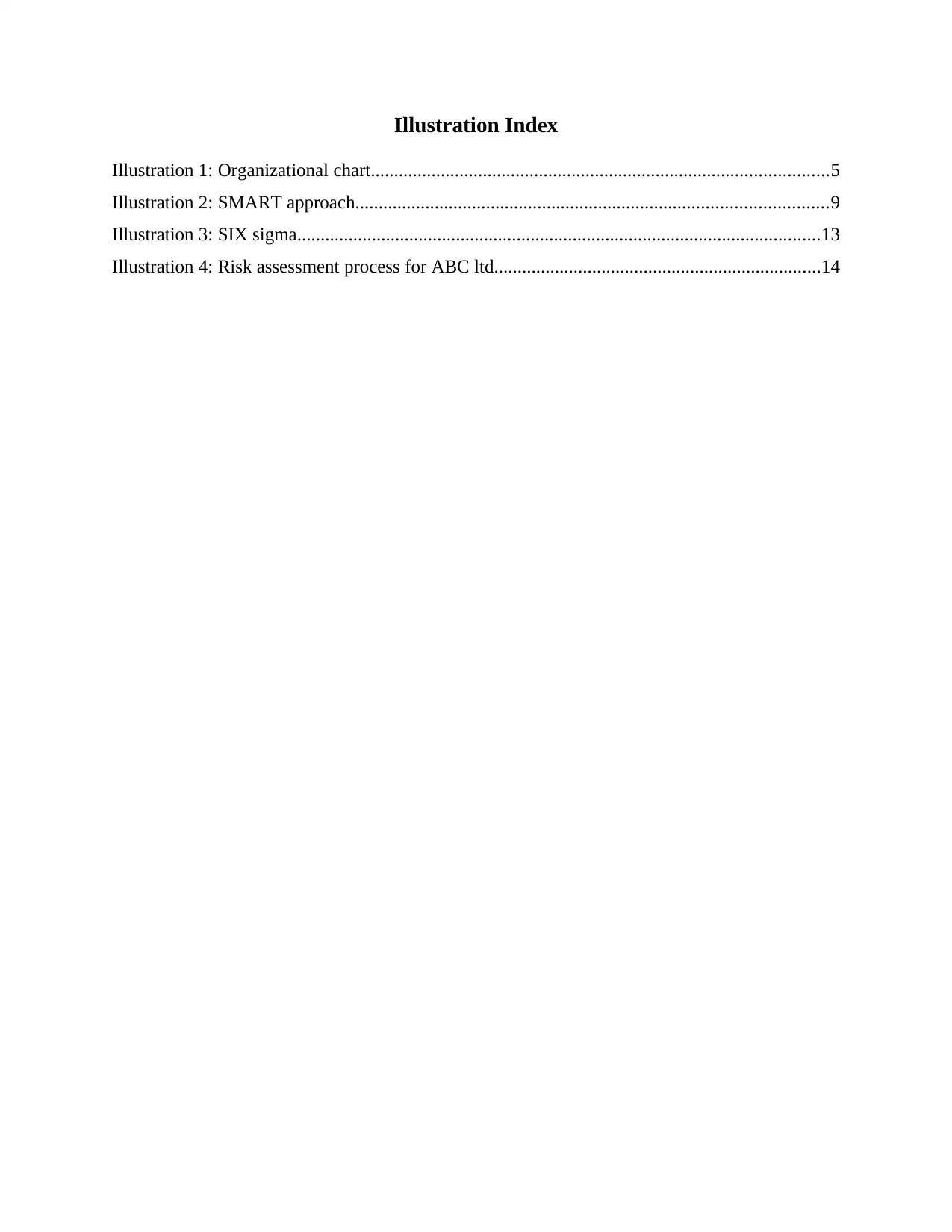
Illustration Index
Illustration 1: Organizational chart..................................................................................................5
Illustration 2: SMART approach.....................................................................................................9
Illustration 3: SIX sigma................................................................................................................13
Illustration 4: Risk assessment process for ABC ltd......................................................................14
Illustration 1: Organizational chart..................................................................................................5
Illustration 2: SMART approach.....................................................................................................9
Illustration 3: SIX sigma................................................................................................................13
Illustration 4: Risk assessment process for ABC ltd......................................................................14
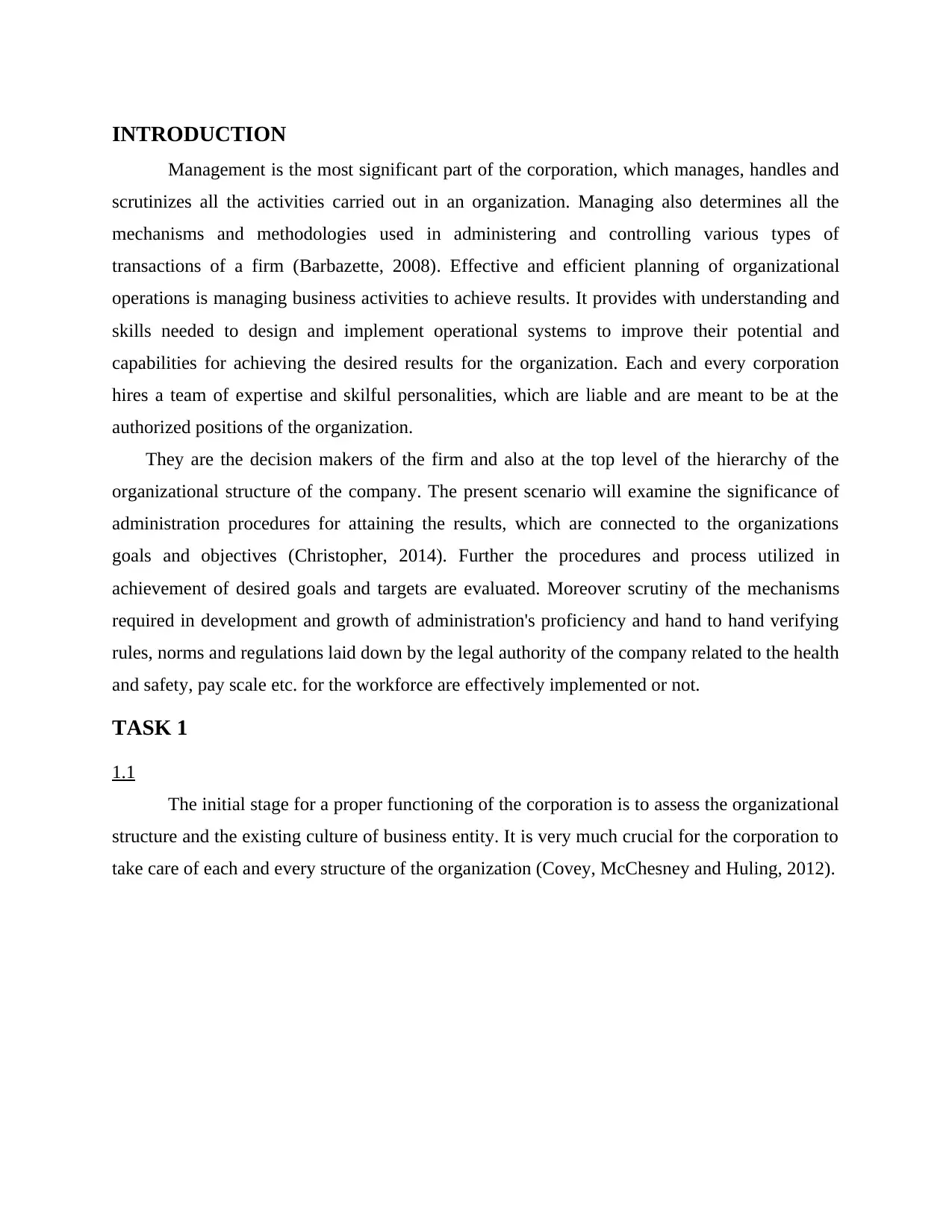
INTRODUCTION
Management is the most significant part of the corporation, which manages, handles and
scrutinizes all the activities carried out in an organization. Managing also determines all the
mechanisms and methodologies used in administering and controlling various types of
transactions of a firm (Barbazette, 2008). Effective and efficient planning of organizational
operations is managing business activities to achieve results. It provides with understanding and
skills needed to design and implement operational systems to improve their potential and
capabilities for achieving the desired results for the organization. Each and every corporation
hires a team of expertise and skilful personalities, which are liable and are meant to be at the
authorized positions of the organization.
They are the decision makers of the firm and also at the top level of the hierarchy of the
organizational structure of the company. The present scenario will examine the significance of
administration procedures for attaining the results, which are connected to the organizations
goals and objectives (Christopher, 2014). Further the procedures and process utilized in
achievement of desired goals and targets are evaluated. Moreover scrutiny of the mechanisms
required in development and growth of administration's proficiency and hand to hand verifying
rules, norms and regulations laid down by the legal authority of the company related to the health
and safety, pay scale etc. for the workforce are effectively implemented or not.
TASK 1
1.1
The initial stage for a proper functioning of the corporation is to assess the organizational
structure and the existing culture of business entity. It is very much crucial for the corporation to
take care of each and every structure of the organization (Covey, McChesney and Huling, 2012).
Management is the most significant part of the corporation, which manages, handles and
scrutinizes all the activities carried out in an organization. Managing also determines all the
mechanisms and methodologies used in administering and controlling various types of
transactions of a firm (Barbazette, 2008). Effective and efficient planning of organizational
operations is managing business activities to achieve results. It provides with understanding and
skills needed to design and implement operational systems to improve their potential and
capabilities for achieving the desired results for the organization. Each and every corporation
hires a team of expertise and skilful personalities, which are liable and are meant to be at the
authorized positions of the organization.
They are the decision makers of the firm and also at the top level of the hierarchy of the
organizational structure of the company. The present scenario will examine the significance of
administration procedures for attaining the results, which are connected to the organizations
goals and objectives (Christopher, 2014). Further the procedures and process utilized in
achievement of desired goals and targets are evaluated. Moreover scrutiny of the mechanisms
required in development and growth of administration's proficiency and hand to hand verifying
rules, norms and regulations laid down by the legal authority of the company related to the health
and safety, pay scale etc. for the workforce are effectively implemented or not.
TASK 1
1.1
The initial stage for a proper functioning of the corporation is to assess the organizational
structure and the existing culture of business entity. It is very much crucial for the corporation to
take care of each and every structure of the organization (Covey, McChesney and Huling, 2012).
Secure Best Marks with AI Grader
Need help grading? Try our AI Grader for instant feedback on your assignments.
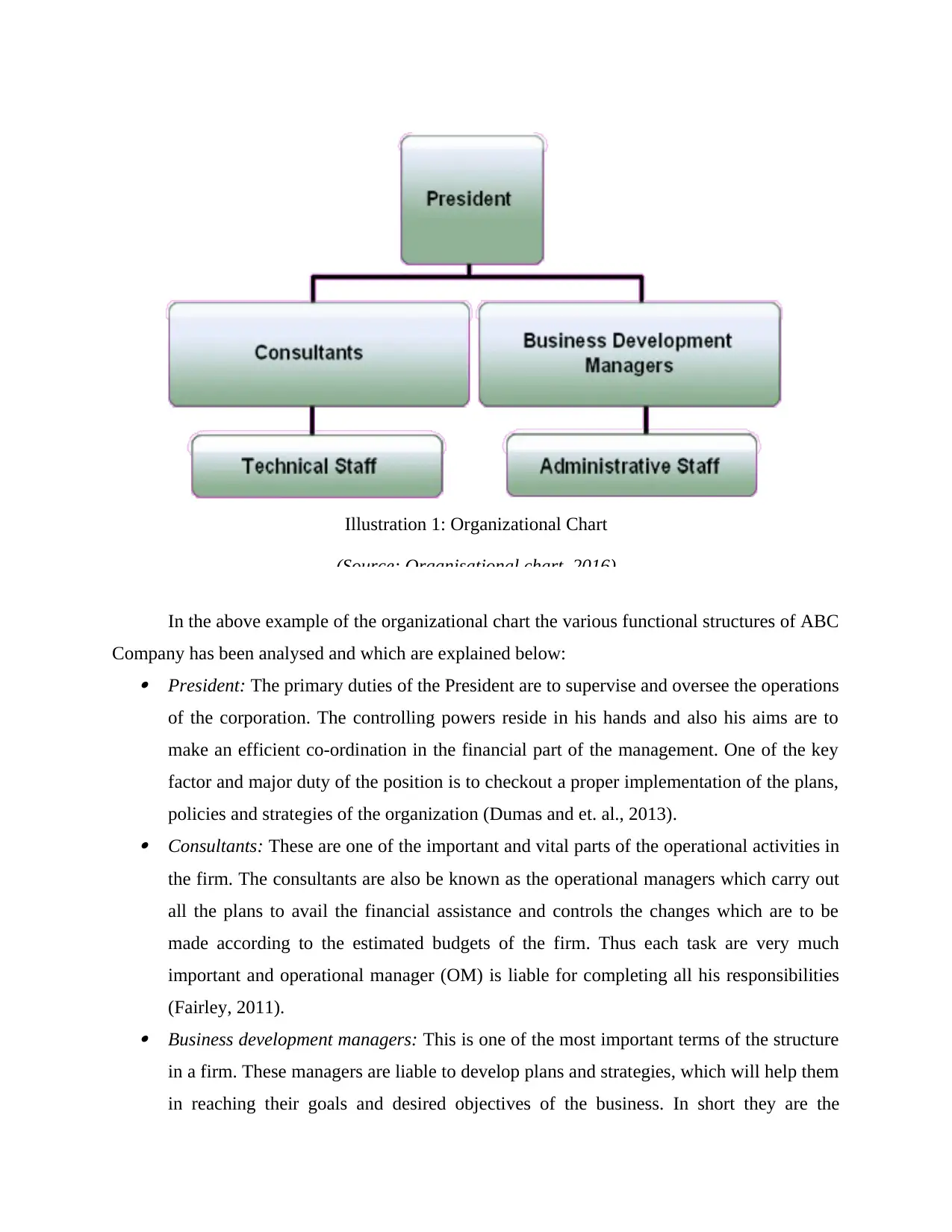
In the above example of the organizational chart the various functional structures of ABC
Company has been analysed and which are explained below: President: The primary duties of the President are to supervise and oversee the operations
of the corporation. The controlling powers reside in his hands and also his aims are to
make an efficient co-ordination in the financial part of the management. One of the key
factor and major duty of the position is to checkout a proper implementation of the plans,
policies and strategies of the organization (Dumas and et. al., 2013). Consultants: These are one of the important and vital parts of the operational activities in
the firm. The consultants are also be known as the operational managers which carry out
all the plans to avail the financial assistance and controls the changes which are to be
made according to the estimated budgets of the firm. Thus each task are very much
important and operational manager (OM) is liable for completing all his responsibilities
(Fairley, 2011). Business development managers: This is one of the most important terms of the structure
in a firm. These managers are liable to develop plans and strategies, which will help them
in reaching their goals and desired objectives of the business. In short they are the
Illustration 1: Organizational Chart
(Source: Organisational chart, 2016)
Company has been analysed and which are explained below: President: The primary duties of the President are to supervise and oversee the operations
of the corporation. The controlling powers reside in his hands and also his aims are to
make an efficient co-ordination in the financial part of the management. One of the key
factor and major duty of the position is to checkout a proper implementation of the plans,
policies and strategies of the organization (Dumas and et. al., 2013). Consultants: These are one of the important and vital parts of the operational activities in
the firm. The consultants are also be known as the operational managers which carry out
all the plans to avail the financial assistance and controls the changes which are to be
made according to the estimated budgets of the firm. Thus each task are very much
important and operational manager (OM) is liable for completing all his responsibilities
(Fairley, 2011). Business development managers: This is one of the most important terms of the structure
in a firm. These managers are liable to develop plans and strategies, which will help them
in reaching their goals and desired objectives of the business. In short they are the
Illustration 1: Organizational Chart
(Source: Organisational chart, 2016)
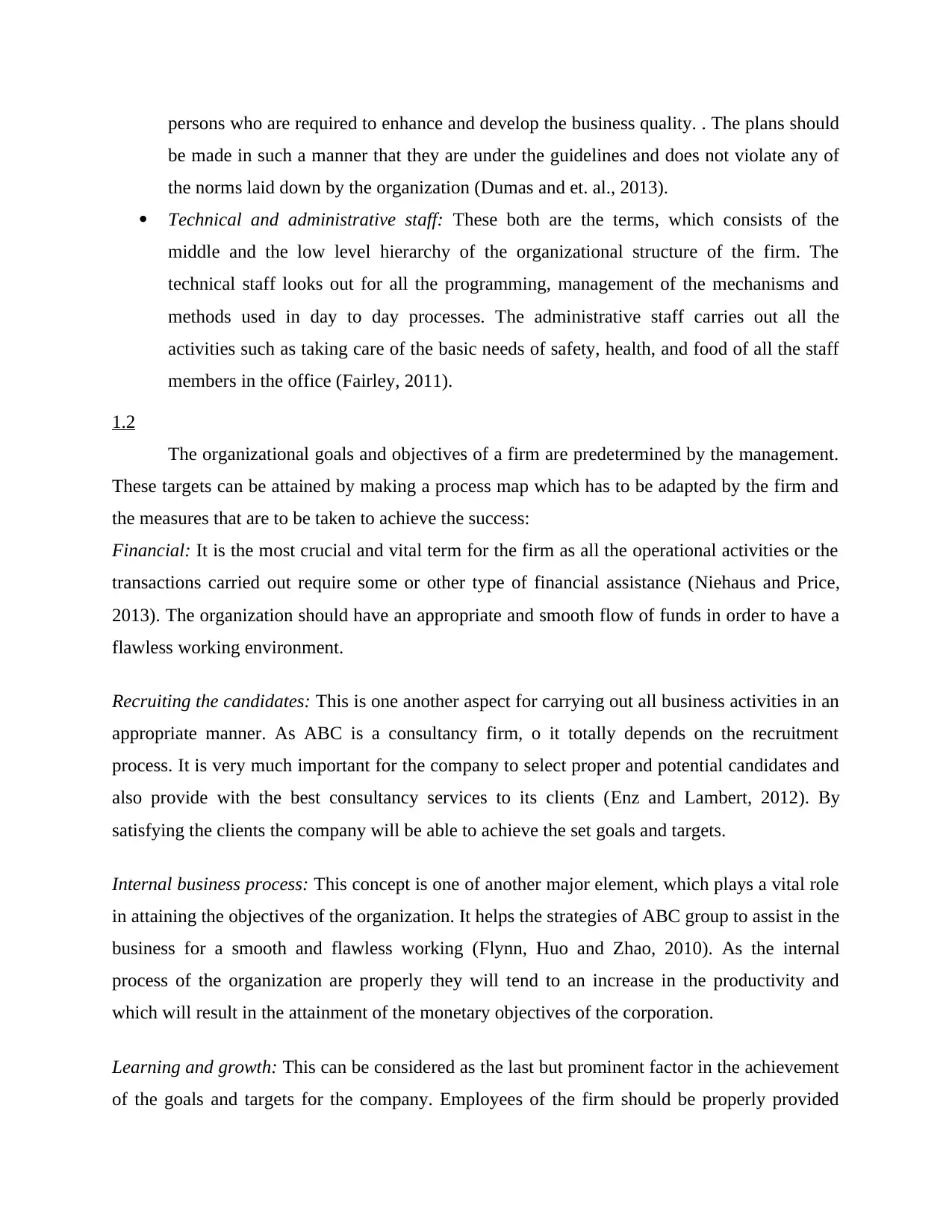
persons who are required to enhance and develop the business quality. . The plans should
be made in such a manner that they are under the guidelines and does not violate any of
the norms laid down by the organization (Dumas and et. al., 2013).
Technical and administrative staff: These both are the terms, which consists of the
middle and the low level hierarchy of the organizational structure of the firm. The
technical staff looks out for all the programming, management of the mechanisms and
methods used in day to day processes. The administrative staff carries out all the
activities such as taking care of the basic needs of safety, health, and food of all the staff
members in the office (Fairley, 2011).
1.2
The organizational goals and objectives of a firm are predetermined by the management.
These targets can be attained by making a process map which has to be adapted by the firm and
the measures that are to be taken to achieve the success:
Financial: It is the most crucial and vital term for the firm as all the operational activities or the
transactions carried out require some or other type of financial assistance (Niehaus and Price,
2013). The organization should have an appropriate and smooth flow of funds in order to have a
flawless working environment.
Recruiting the candidates: This is one another aspect for carrying out all business activities in an
appropriate manner. As ABC is a consultancy firm, o it totally depends on the recruitment
process. It is very much important for the company to select proper and potential candidates and
also provide with the best consultancy services to its clients (Enz and Lambert, 2012). By
satisfying the clients the company will be able to achieve the set goals and targets.
Internal business process: This concept is one of another major element, which plays a vital role
in attaining the objectives of the organization. It helps the strategies of ABC group to assist in the
business for a smooth and flawless working (Flynn, Huo and Zhao, 2010). As the internal
process of the organization are properly they will tend to an increase in the productivity and
which will result in the attainment of the monetary objectives of the corporation.
Learning and growth: This can be considered as the last but prominent factor in the achievement
of the goals and targets for the company. Employees of the firm should be properly provided
be made in such a manner that they are under the guidelines and does not violate any of
the norms laid down by the organization (Dumas and et. al., 2013).
Technical and administrative staff: These both are the terms, which consists of the
middle and the low level hierarchy of the organizational structure of the firm. The
technical staff looks out for all the programming, management of the mechanisms and
methods used in day to day processes. The administrative staff carries out all the
activities such as taking care of the basic needs of safety, health, and food of all the staff
members in the office (Fairley, 2011).
1.2
The organizational goals and objectives of a firm are predetermined by the management.
These targets can be attained by making a process map which has to be adapted by the firm and
the measures that are to be taken to achieve the success:
Financial: It is the most crucial and vital term for the firm as all the operational activities or the
transactions carried out require some or other type of financial assistance (Niehaus and Price,
2013). The organization should have an appropriate and smooth flow of funds in order to have a
flawless working environment.
Recruiting the candidates: This is one another aspect for carrying out all business activities in an
appropriate manner. As ABC is a consultancy firm, o it totally depends on the recruitment
process. It is very much important for the company to select proper and potential candidates and
also provide with the best consultancy services to its clients (Enz and Lambert, 2012). By
satisfying the clients the company will be able to achieve the set goals and targets.
Internal business process: This concept is one of another major element, which plays a vital role
in attaining the objectives of the organization. It helps the strategies of ABC group to assist in the
business for a smooth and flawless working (Flynn, Huo and Zhao, 2010). As the internal
process of the organization are properly they will tend to an increase in the productivity and
which will result in the attainment of the monetary objectives of the corporation.
Learning and growth: This can be considered as the last but prominent factor in the achievement
of the goals and targets for the company. Employees of the firm should be properly provided
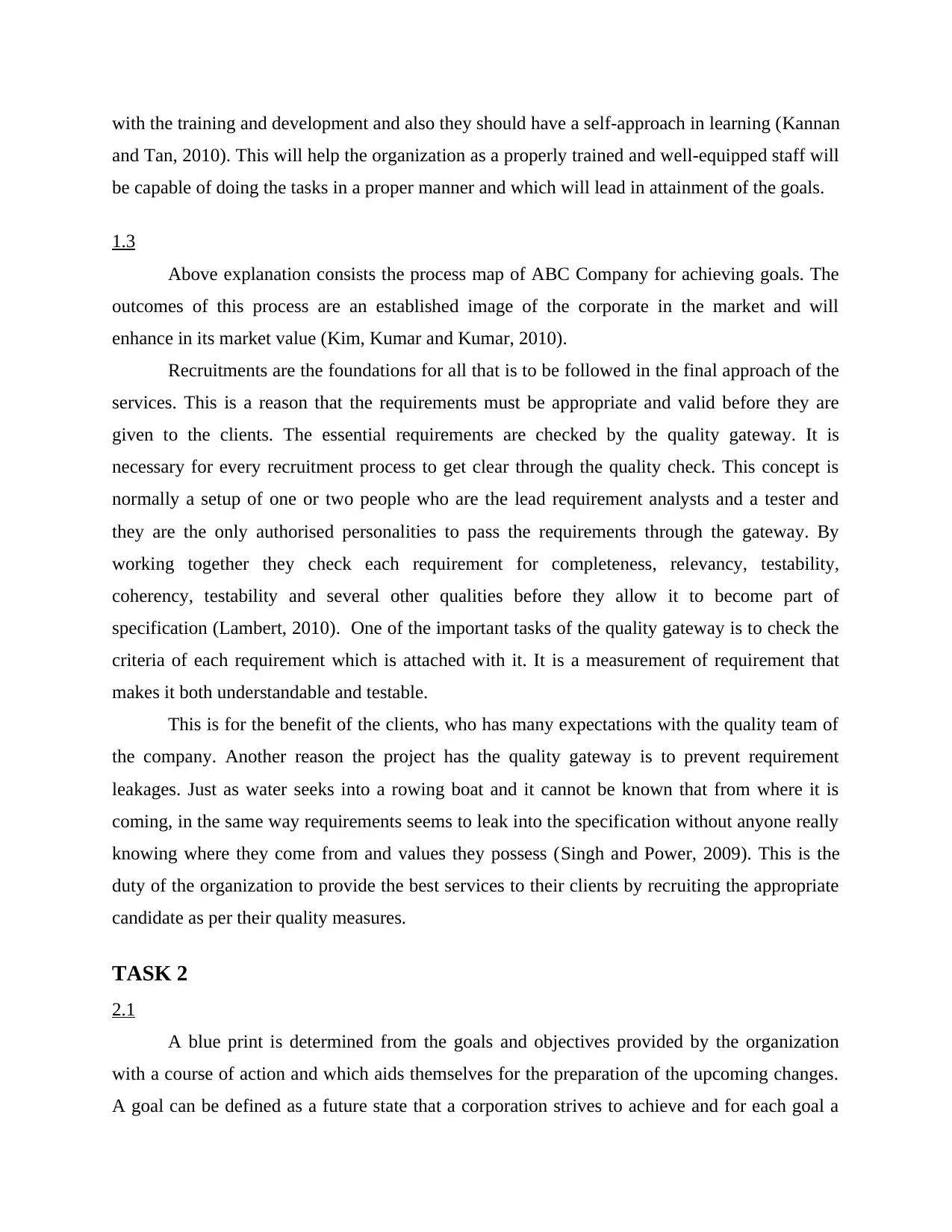
with the training and development and also they should have a self-approach in learning (Kannan
and Tan, 2010). This will help the organization as a properly trained and well-equipped staff will
be capable of doing the tasks in a proper manner and which will lead in attainment of the goals.
1.3
Above explanation consists the process map of ABC Company for achieving goals. The
outcomes of this process are an established image of the corporate in the market and will
enhance in its market value (Kim, Kumar and Kumar, 2010).
Recruitments are the foundations for all that is to be followed in the final approach of the
services. This is a reason that the requirements must be appropriate and valid before they are
given to the clients. The essential requirements are checked by the quality gateway. It is
necessary for every recruitment process to get clear through the quality check. This concept is
normally a setup of one or two people who are the lead requirement analysts and a tester and
they are the only authorised personalities to pass the requirements through the gateway. By
working together they check each requirement for completeness, relevancy, testability,
coherency, testability and several other qualities before they allow it to become part of
specification (Lambert, 2010). One of the important tasks of the quality gateway is to check the
criteria of each requirement which is attached with it. It is a measurement of requirement that
makes it both understandable and testable.
This is for the benefit of the clients, who has many expectations with the quality team of
the company. Another reason the project has the quality gateway is to prevent requirement
leakages. Just as water seeks into a rowing boat and it cannot be known that from where it is
coming, in the same way requirements seems to leak into the specification without anyone really
knowing where they come from and values they possess (Singh and Power, 2009). This is the
duty of the organization to provide the best services to their clients by recruiting the appropriate
candidate as per their quality measures.
TASK 2
2.1
A blue print is determined from the goals and objectives provided by the organization
with a course of action and which aids themselves for the preparation of the upcoming changes.
A goal can be defined as a future state that a corporation strives to achieve and for each goal a
and Tan, 2010). This will help the organization as a properly trained and well-equipped staff will
be capable of doing the tasks in a proper manner and which will lead in attainment of the goals.
1.3
Above explanation consists the process map of ABC Company for achieving goals. The
outcomes of this process are an established image of the corporate in the market and will
enhance in its market value (Kim, Kumar and Kumar, 2010).
Recruitments are the foundations for all that is to be followed in the final approach of the
services. This is a reason that the requirements must be appropriate and valid before they are
given to the clients. The essential requirements are checked by the quality gateway. It is
necessary for every recruitment process to get clear through the quality check. This concept is
normally a setup of one or two people who are the lead requirement analysts and a tester and
they are the only authorised personalities to pass the requirements through the gateway. By
working together they check each requirement for completeness, relevancy, testability,
coherency, testability and several other qualities before they allow it to become part of
specification (Lambert, 2010). One of the important tasks of the quality gateway is to check the
criteria of each requirement which is attached with it. It is a measurement of requirement that
makes it both understandable and testable.
This is for the benefit of the clients, who has many expectations with the quality team of
the company. Another reason the project has the quality gateway is to prevent requirement
leakages. Just as water seeks into a rowing boat and it cannot be known that from where it is
coming, in the same way requirements seems to leak into the specification without anyone really
knowing where they come from and values they possess (Singh and Power, 2009). This is the
duty of the organization to provide the best services to their clients by recruiting the appropriate
candidate as per their quality measures.
TASK 2
2.1
A blue print is determined from the goals and objectives provided by the organization
with a course of action and which aids themselves for the preparation of the upcoming changes.
A goal can be defined as a future state that a corporation strives to achieve and for each goal a
Paraphrase This Document
Need a fresh take? Get an instant paraphrase of this document with our AI Paraphraser
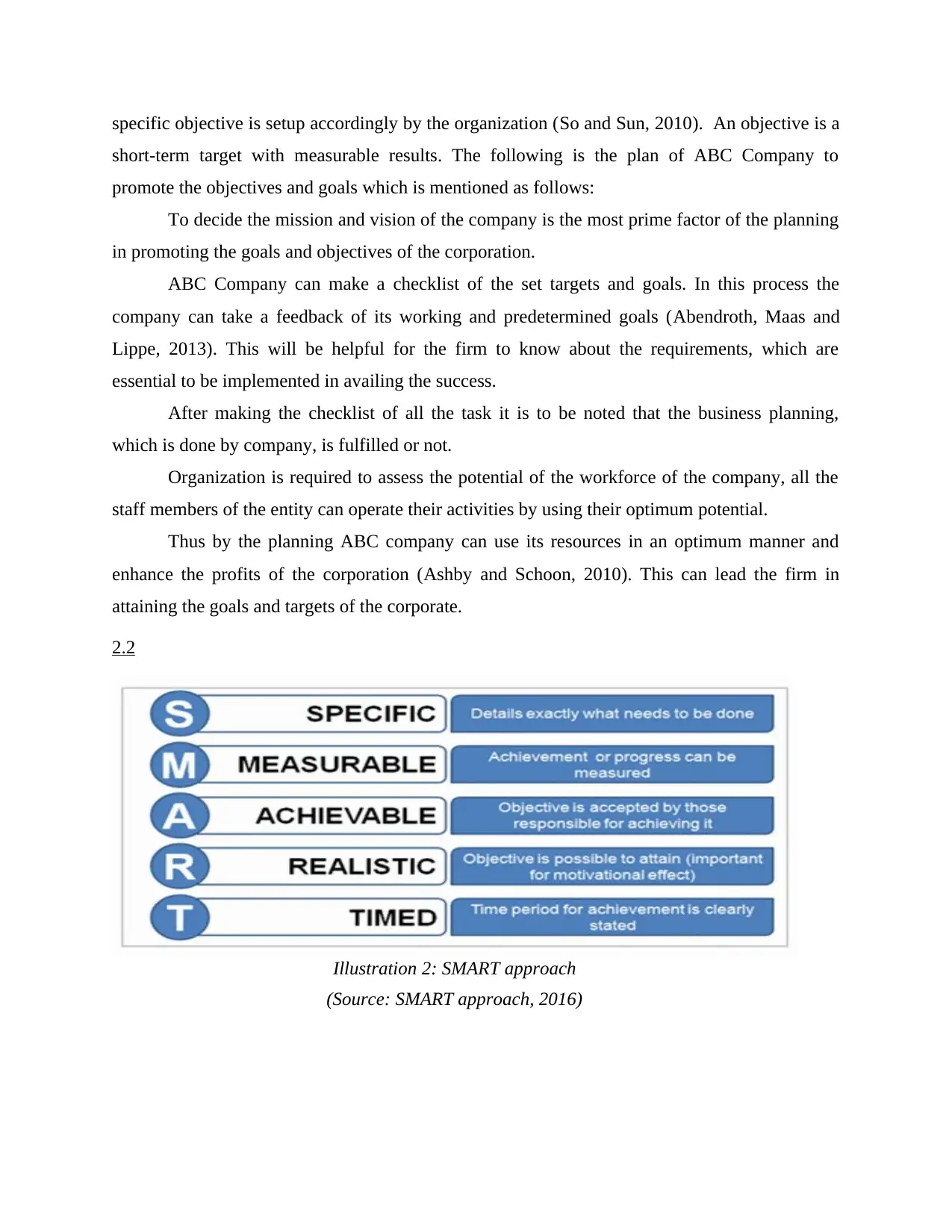
specific objective is setup accordingly by the organization (So and Sun, 2010). An objective is a
short-term target with measurable results. The following is the plan of ABC Company to
promote the objectives and goals which is mentioned as follows:
To decide the mission and vision of the company is the most prime factor of the planning
in promoting the goals and objectives of the corporation.
ABC Company can make a checklist of the set targets and goals. In this process the
company can take a feedback of its working and predetermined goals (Abendroth, Maas and
Lippe, 2013). This will be helpful for the firm to know about the requirements, which are
essential to be implemented in availing the success.
After making the checklist of all the task it is to be noted that the business planning,
which is done by company, is fulfilled or not.
Organization is required to assess the potential of the workforce of the company, all the
staff members of the entity can operate their activities by using their optimum potential.
Thus by the planning ABC company can use its resources in an optimum manner and
enhance the profits of the corporation (Ashby and Schoon, 2010). This can lead the firm in
attaining the goals and targets of the corporate.
2.2
Illustration 2: SMART approach
(Source: SMART approach, 2016)
short-term target with measurable results. The following is the plan of ABC Company to
promote the objectives and goals which is mentioned as follows:
To decide the mission and vision of the company is the most prime factor of the planning
in promoting the goals and objectives of the corporation.
ABC Company can make a checklist of the set targets and goals. In this process the
company can take a feedback of its working and predetermined goals (Abendroth, Maas and
Lippe, 2013). This will be helpful for the firm to know about the requirements, which are
essential to be implemented in availing the success.
After making the checklist of all the task it is to be noted that the business planning,
which is done by company, is fulfilled or not.
Organization is required to assess the potential of the workforce of the company, all the
staff members of the entity can operate their activities by using their optimum potential.
Thus by the planning ABC company can use its resources in an optimum manner and
enhance the profits of the corporation (Ashby and Schoon, 2010). This can lead the firm in
attaining the goals and targets of the corporate.
2.2
Illustration 2: SMART approach
(Source: SMART approach, 2016)
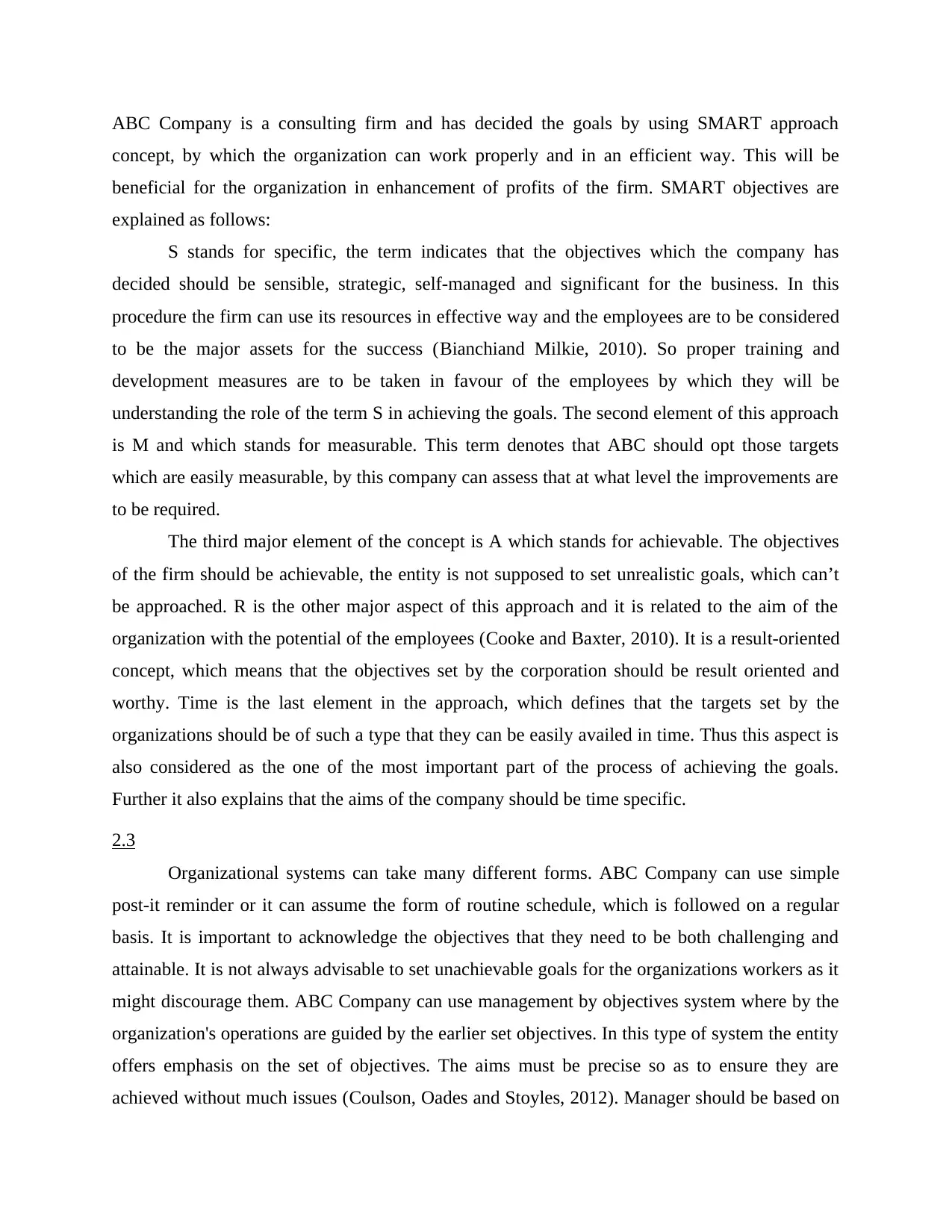
ABC Company is a consulting firm and has decided the goals by using SMART approach
concept, by which the organization can work properly and in an efficient way. This will be
beneficial for the organization in enhancement of profits of the firm. SMART objectives are
explained as follows:
S stands for specific, the term indicates that the objectives which the company has
decided should be sensible, strategic, self-managed and significant for the business. In this
procedure the firm can use its resources in effective way and the employees are to be considered
to be the major assets for the success (Bianchiand Milkie, 2010). So proper training and
development measures are to be taken in favour of the employees by which they will be
understanding the role of the term S in achieving the goals. The second element of this approach
is M and which stands for measurable. This term denotes that ABC should opt those targets
which are easily measurable, by this company can assess that at what level the improvements are
to be required.
The third major element of the concept is A which stands for achievable. The objectives
of the firm should be achievable, the entity is not supposed to set unrealistic goals, which can’t
be approached. R is the other major aspect of this approach and it is related to the aim of the
organization with the potential of the employees (Cooke and Baxter, 2010). It is a result-oriented
concept, which means that the objectives set by the corporation should be result oriented and
worthy. Time is the last element in the approach, which defines that the targets set by the
organizations should be of such a type that they can be easily availed in time. Thus this aspect is
also considered as the one of the most important part of the process of achieving the goals.
Further it also explains that the aims of the company should be time specific.
2.3
Organizational systems can take many different forms. ABC Company can use simple
post-it reminder or it can assume the form of routine schedule, which is followed on a regular
basis. It is important to acknowledge the objectives that they need to be both challenging and
attainable. It is not always advisable to set unachievable goals for the organizations workers as it
might discourage them. ABC Company can use management by objectives system where by the
organization's operations are guided by the earlier set objectives. In this type of system the entity
offers emphasis on the set of objectives. The aims must be precise so as to ensure they are
achieved without much issues (Coulson, Oades and Stoyles, 2012). Manager should be based on
concept, by which the organization can work properly and in an efficient way. This will be
beneficial for the organization in enhancement of profits of the firm. SMART objectives are
explained as follows:
S stands for specific, the term indicates that the objectives which the company has
decided should be sensible, strategic, self-managed and significant for the business. In this
procedure the firm can use its resources in effective way and the employees are to be considered
to be the major assets for the success (Bianchiand Milkie, 2010). So proper training and
development measures are to be taken in favour of the employees by which they will be
understanding the role of the term S in achieving the goals. The second element of this approach
is M and which stands for measurable. This term denotes that ABC should opt those targets
which are easily measurable, by this company can assess that at what level the improvements are
to be required.
The third major element of the concept is A which stands for achievable. The objectives
of the firm should be achievable, the entity is not supposed to set unrealistic goals, which can’t
be approached. R is the other major aspect of this approach and it is related to the aim of the
organization with the potential of the employees (Cooke and Baxter, 2010). It is a result-oriented
concept, which means that the objectives set by the corporation should be result oriented and
worthy. Time is the last element in the approach, which defines that the targets set by the
organizations should be of such a type that they can be easily availed in time. Thus this aspect is
also considered as the one of the most important part of the process of achieving the goals.
Further it also explains that the aims of the company should be time specific.
2.3
Organizational systems can take many different forms. ABC Company can use simple
post-it reminder or it can assume the form of routine schedule, which is followed on a regular
basis. It is important to acknowledge the objectives that they need to be both challenging and
attainable. It is not always advisable to set unachievable goals for the organizations workers as it
might discourage them. ABC Company can use management by objectives system where by the
organization's operations are guided by the earlier set objectives. In this type of system the entity
offers emphasis on the set of objectives. The aims must be precise so as to ensure they are
achieved without much issues (Coulson, Oades and Stoyles, 2012). Manager should be based on
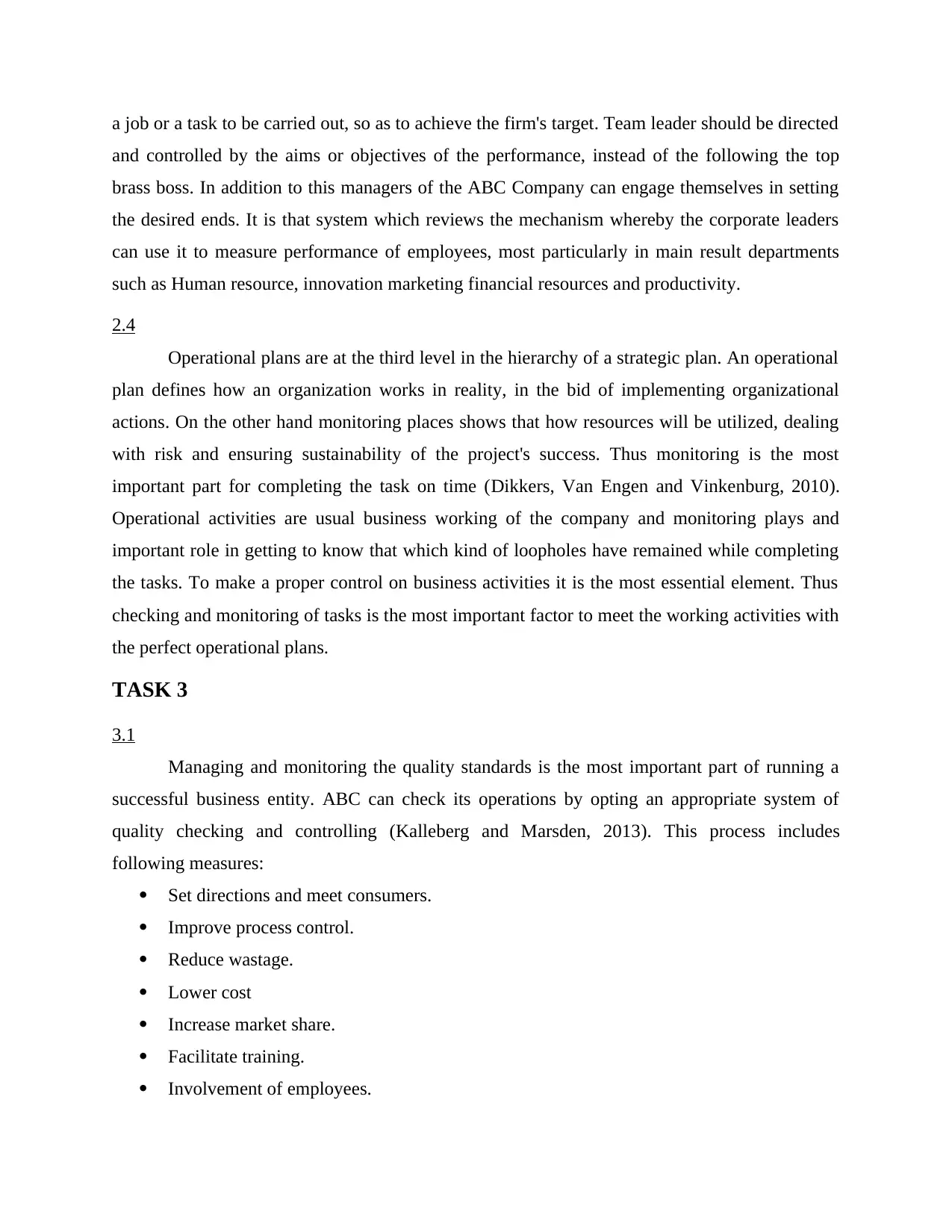
a job or a task to be carried out, so as to achieve the firm's target. Team leader should be directed
and controlled by the aims or objectives of the performance, instead of the following the top
brass boss. In addition to this managers of the ABC Company can engage themselves in setting
the desired ends. It is that system which reviews the mechanism whereby the corporate leaders
can use it to measure performance of employees, most particularly in main result departments
such as Human resource, innovation marketing financial resources and productivity.
2.4
Operational plans are at the third level in the hierarchy of a strategic plan. An operational
plan defines how an organization works in reality, in the bid of implementing organizational
actions. On the other hand monitoring places shows that how resources will be utilized, dealing
with risk and ensuring sustainability of the project's success. Thus monitoring is the most
important part for completing the task on time (Dikkers, Van Engen and Vinkenburg, 2010).
Operational activities are usual business working of the company and monitoring plays and
important role in getting to know that which kind of loopholes have remained while completing
the tasks. To make a proper control on business activities it is the most essential element. Thus
checking and monitoring of tasks is the most important factor to meet the working activities with
the perfect operational plans.
TASK 3
3.1
Managing and monitoring the quality standards is the most important part of running a
successful business entity. ABC can check its operations by opting an appropriate system of
quality checking and controlling (Kalleberg and Marsden, 2013). This process includes
following measures:
Set directions and meet consumers.
Improve process control.
Reduce wastage.
Lower cost
Increase market share.
Facilitate training.
Involvement of employees.
and controlled by the aims or objectives of the performance, instead of the following the top
brass boss. In addition to this managers of the ABC Company can engage themselves in setting
the desired ends. It is that system which reviews the mechanism whereby the corporate leaders
can use it to measure performance of employees, most particularly in main result departments
such as Human resource, innovation marketing financial resources and productivity.
2.4
Operational plans are at the third level in the hierarchy of a strategic plan. An operational
plan defines how an organization works in reality, in the bid of implementing organizational
actions. On the other hand monitoring places shows that how resources will be utilized, dealing
with risk and ensuring sustainability of the project's success. Thus monitoring is the most
important part for completing the task on time (Dikkers, Van Engen and Vinkenburg, 2010).
Operational activities are usual business working of the company and monitoring plays and
important role in getting to know that which kind of loopholes have remained while completing
the tasks. To make a proper control on business activities it is the most essential element. Thus
checking and monitoring of tasks is the most important factor to meet the working activities with
the perfect operational plans.
TASK 3
3.1
Managing and monitoring the quality standards is the most important part of running a
successful business entity. ABC can check its operations by opting an appropriate system of
quality checking and controlling (Kalleberg and Marsden, 2013). This process includes
following measures:
Set directions and meet consumers.
Improve process control.
Reduce wastage.
Lower cost
Increase market share.
Facilitate training.
Involvement of employees.
Secure Best Marks with AI Grader
Need help grading? Try our AI Grader for instant feedback on your assignments.
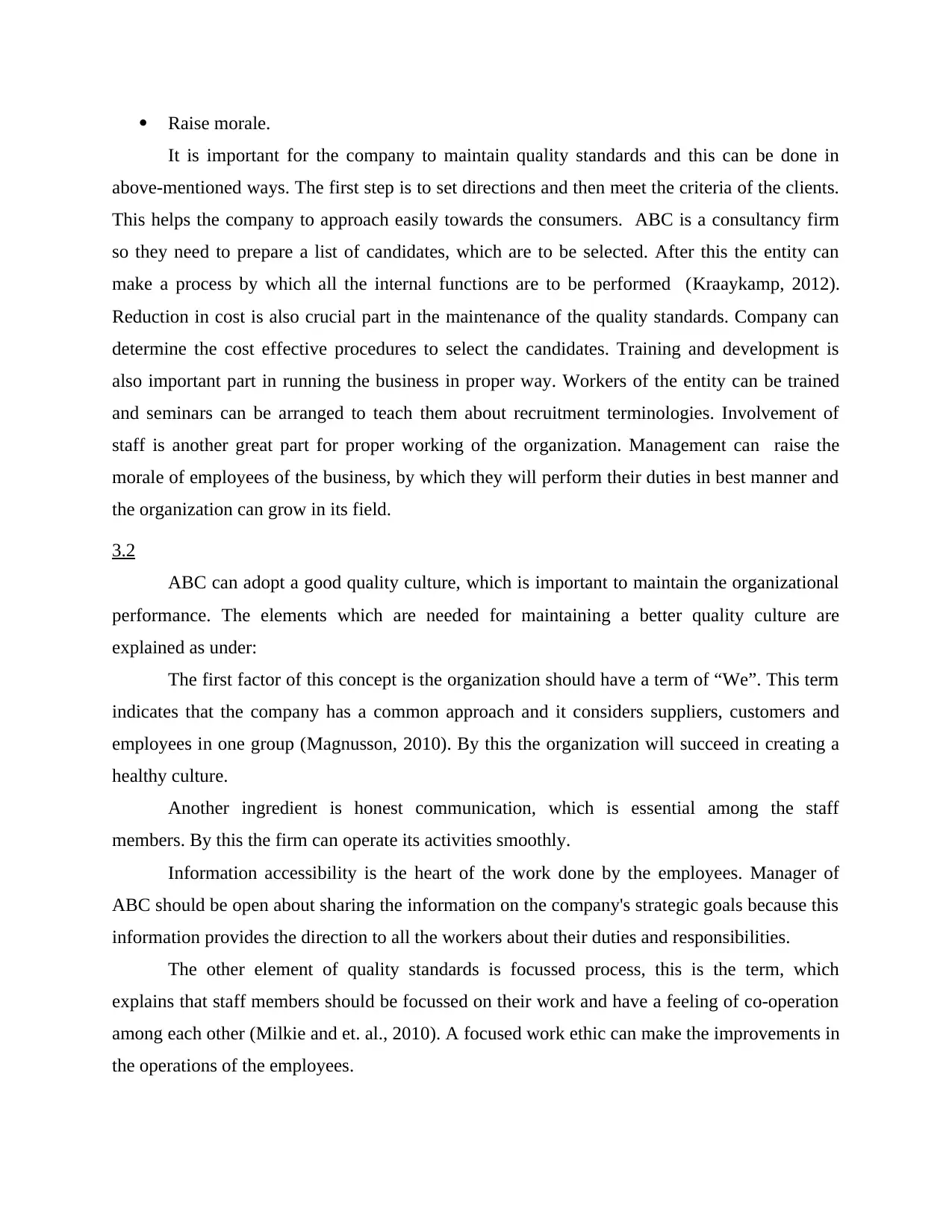
Raise morale.
It is important for the company to maintain quality standards and this can be done in
above-mentioned ways. The first step is to set directions and then meet the criteria of the clients.
This helps the company to approach easily towards the consumers. ABC is a consultancy firm
so they need to prepare a list of candidates, which are to be selected. After this the entity can
make a process by which all the internal functions are to be performed (Kraaykamp, 2012).
Reduction in cost is also crucial part in the maintenance of the quality standards. Company can
determine the cost effective procedures to select the candidates. Training and development is
also important part in running the business in proper way. Workers of the entity can be trained
and seminars can be arranged to teach them about recruitment terminologies. Involvement of
staff is another great part for proper working of the organization. Management can raise the
morale of employees of the business, by which they will perform their duties in best manner and
the organization can grow in its field.
3.2
ABC can adopt a good quality culture, which is important to maintain the organizational
performance. The elements which are needed for maintaining a better quality culture are
explained as under:
The first factor of this concept is the organization should have a term of “We”. This term
indicates that the company has a common approach and it considers suppliers, customers and
employees in one group (Magnusson, 2010). By this the organization will succeed in creating a
healthy culture.
Another ingredient is honest communication, which is essential among the staff
members. By this the firm can operate its activities smoothly.
Information accessibility is the heart of the work done by the employees. Manager of
ABC should be open about sharing the information on the company's strategic goals because this
information provides the direction to all the workers about their duties and responsibilities.
The other element of quality standards is focussed process, this is the term, which
explains that staff members should be focussed on their work and have a feeling of co-operation
among each other (Milkie and et. al., 2010). A focused work ethic can make the improvements in
the operations of the employees.
It is important for the company to maintain quality standards and this can be done in
above-mentioned ways. The first step is to set directions and then meet the criteria of the clients.
This helps the company to approach easily towards the consumers. ABC is a consultancy firm
so they need to prepare a list of candidates, which are to be selected. After this the entity can
make a process by which all the internal functions are to be performed (Kraaykamp, 2012).
Reduction in cost is also crucial part in the maintenance of the quality standards. Company can
determine the cost effective procedures to select the candidates. Training and development is
also important part in running the business in proper way. Workers of the entity can be trained
and seminars can be arranged to teach them about recruitment terminologies. Involvement of
staff is another great part for proper working of the organization. Management can raise the
morale of employees of the business, by which they will perform their duties in best manner and
the organization can grow in its field.
3.2
ABC can adopt a good quality culture, which is important to maintain the organizational
performance. The elements which are needed for maintaining a better quality culture are
explained as under:
The first factor of this concept is the organization should have a term of “We”. This term
indicates that the company has a common approach and it considers suppliers, customers and
employees in one group (Magnusson, 2010). By this the organization will succeed in creating a
healthy culture.
Another ingredient is honest communication, which is essential among the staff
members. By this the firm can operate its activities smoothly.
Information accessibility is the heart of the work done by the employees. Manager of
ABC should be open about sharing the information on the company's strategic goals because this
information provides the direction to all the workers about their duties and responsibilities.
The other element of quality standards is focussed process, this is the term, which
explains that staff members should be focussed on their work and have a feeling of co-operation
among each other (Milkie and et. al., 2010). A focused work ethic can make the improvements in
the operations of the employees.
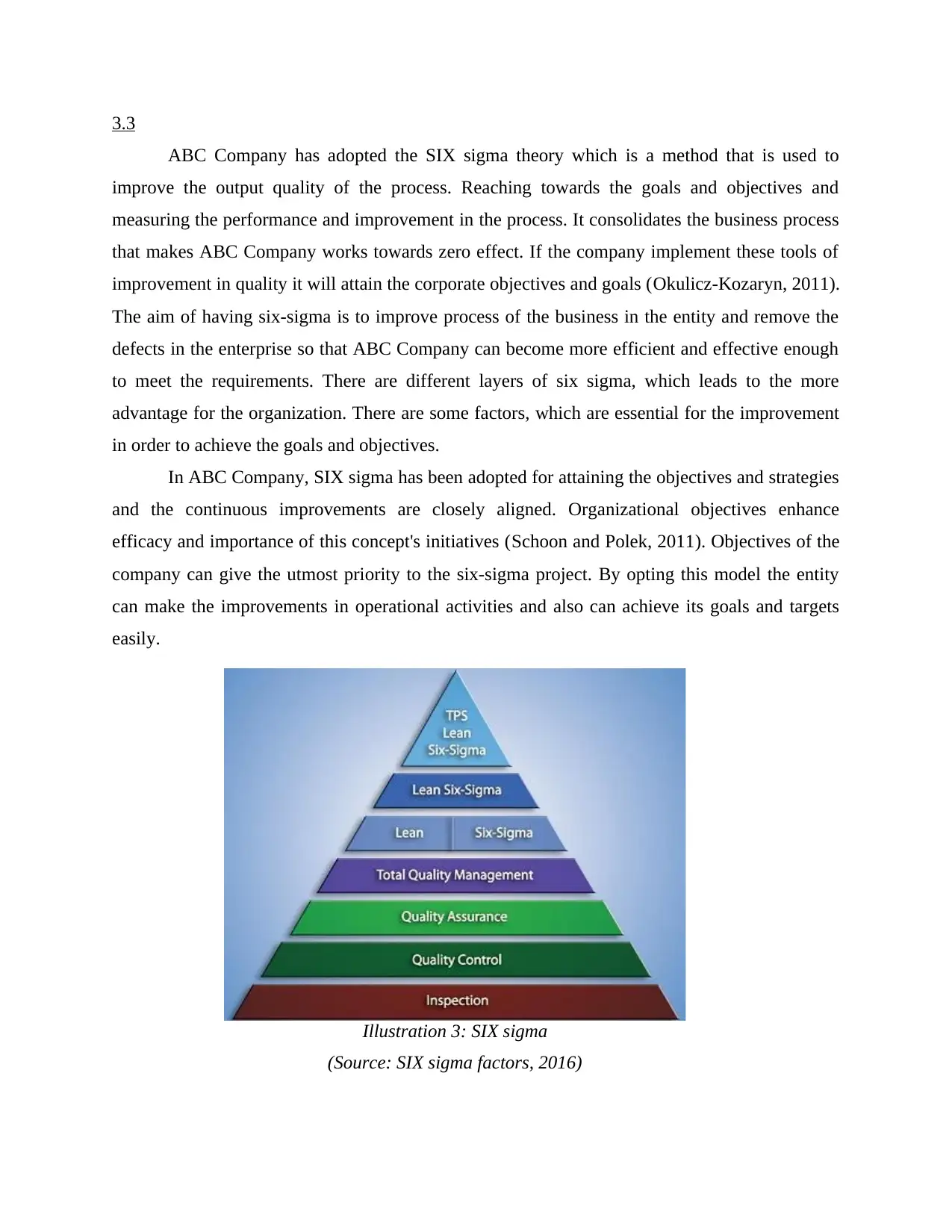
3.3
ABC Company has adopted the SIX sigma theory which is a method that is used to
improve the output quality of the process. Reaching towards the goals and objectives and
measuring the performance and improvement in the process. It consolidates the business process
that makes ABC Company works towards zero effect. If the company implement these tools of
improvement in quality it will attain the corporate objectives and goals (Okulicz-Kozaryn, 2011).
The aim of having six-sigma is to improve process of the business in the entity and remove the
defects in the enterprise so that ABC Company can become more efficient and effective enough
to meet the requirements. There are different layers of six sigma, which leads to the more
advantage for the organization. There are some factors, which are essential for the improvement
in order to achieve the goals and objectives.
In ABC Company, SIX sigma has been adopted for attaining the objectives and strategies
and the continuous improvements are closely aligned. Organizational objectives enhance
efficacy and importance of this concept's initiatives (Schoon and Polek, 2011). Objectives of the
company can give the utmost priority to the six-sigma project. By opting this model the entity
can make the improvements in operational activities and also can achieve its goals and targets
easily.
Illustration 3: SIX sigma
(Source: SIX sigma factors, 2016)
ABC Company has adopted the SIX sigma theory which is a method that is used to
improve the output quality of the process. Reaching towards the goals and objectives and
measuring the performance and improvement in the process. It consolidates the business process
that makes ABC Company works towards zero effect. If the company implement these tools of
improvement in quality it will attain the corporate objectives and goals (Okulicz-Kozaryn, 2011).
The aim of having six-sigma is to improve process of the business in the entity and remove the
defects in the enterprise so that ABC Company can become more efficient and effective enough
to meet the requirements. There are different layers of six sigma, which leads to the more
advantage for the organization. There are some factors, which are essential for the improvement
in order to achieve the goals and objectives.
In ABC Company, SIX sigma has been adopted for attaining the objectives and strategies
and the continuous improvements are closely aligned. Organizational objectives enhance
efficacy and importance of this concept's initiatives (Schoon and Polek, 2011). Objectives of the
company can give the utmost priority to the six-sigma project. By opting this model the entity
can make the improvements in operational activities and also can achieve its goals and targets
easily.
Illustration 3: SIX sigma
(Source: SIX sigma factors, 2016)
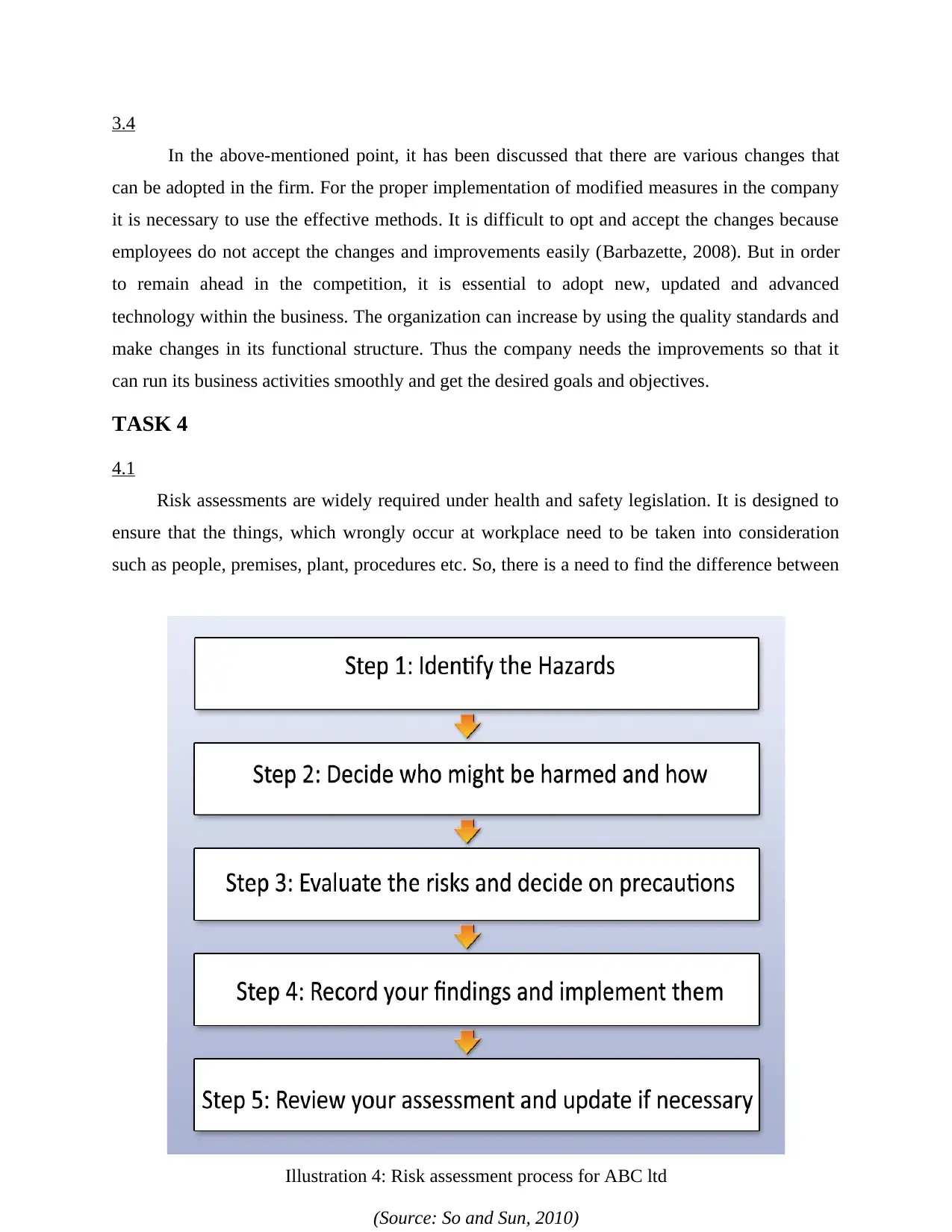
3.4
In the above-mentioned point, it has been discussed that there are various changes that
can be adopted in the firm. For the proper implementation of modified measures in the company
it is necessary to use the effective methods. It is difficult to opt and accept the changes because
employees do not accept the changes and improvements easily (Barbazette, 2008). But in order
to remain ahead in the competition, it is essential to adopt new, updated and advanced
technology within the business. The organization can increase by using the quality standards and
make changes in its functional structure. Thus the company needs the improvements so that it
can run its business activities smoothly and get the desired goals and objectives.
TASK 4
4.1
Risk assessments are widely required under health and safety legislation. It is designed to
ensure that the things, which wrongly occur at workplace need to be taken into consideration
such as people, premises, plant, procedures etc. So, there is a need to find the difference between
Illustration 4: Risk assessment process for ABC ltd
(Source: So and Sun, 2010)
In the above-mentioned point, it has been discussed that there are various changes that
can be adopted in the firm. For the proper implementation of modified measures in the company
it is necessary to use the effective methods. It is difficult to opt and accept the changes because
employees do not accept the changes and improvements easily (Barbazette, 2008). But in order
to remain ahead in the competition, it is essential to adopt new, updated and advanced
technology within the business. The organization can increase by using the quality standards and
make changes in its functional structure. Thus the company needs the improvements so that it
can run its business activities smoothly and get the desired goals and objectives.
TASK 4
4.1
Risk assessments are widely required under health and safety legislation. It is designed to
ensure that the things, which wrongly occur at workplace need to be taken into consideration
such as people, premises, plant, procedures etc. So, there is a need to find the difference between
Illustration 4: Risk assessment process for ABC ltd
(Source: So and Sun, 2010)
Paraphrase This Document
Need a fresh take? Get an instant paraphrase of this document with our AI Paraphraser
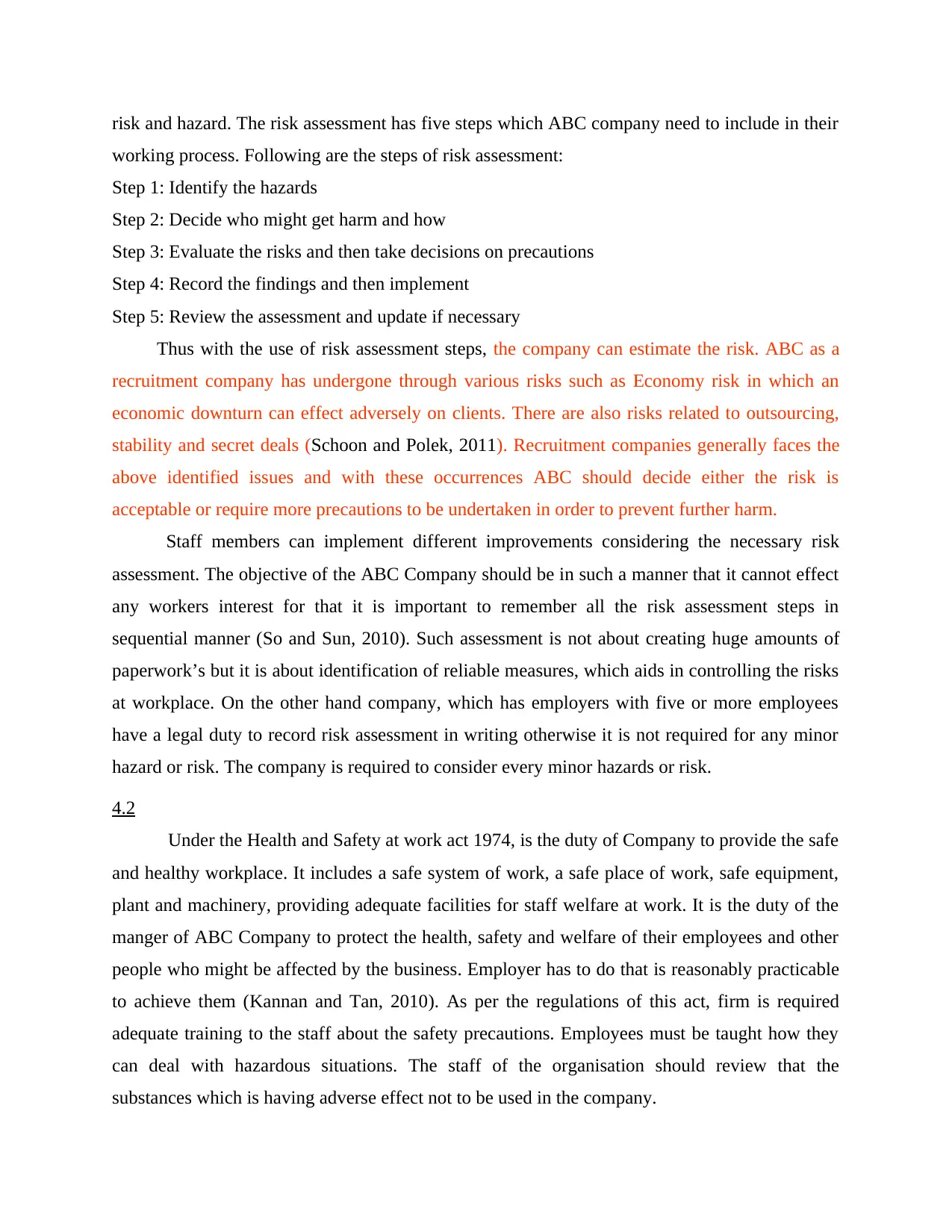
risk and hazard. The risk assessment has five steps which ABC company need to include in their
working process. Following are the steps of risk assessment:
Step 1: Identify the hazards
Step 2: Decide who might get harm and how
Step 3: Evaluate the risks and then take decisions on precautions
Step 4: Record the findings and then implement
Step 5: Review the assessment and update if necessary
Thus with the use of risk assessment steps, the company can estimate the risk. ABC as a
recruitment company has undergone through various risks such as Economy risk in which an
economic downturn can effect adversely on clients. There are also risks related to outsourcing,
stability and secret deals (Schoon and Polek, 2011). Recruitment companies generally faces the
above identified issues and with these occurrences ABC should decide either the risk is
acceptable or require more precautions to be undertaken in order to prevent further harm.
Staff members can implement different improvements considering the necessary risk
assessment. The objective of the ABC Company should be in such a manner that it cannot effect
any workers interest for that it is important to remember all the risk assessment steps in
sequential manner (So and Sun, 2010). Such assessment is not about creating huge amounts of
paperwork’s but it is about identification of reliable measures, which aids in controlling the risks
at workplace. On the other hand company, which has employers with five or more employees
have a legal duty to record risk assessment in writing otherwise it is not required for any minor
hazard or risk. The company is required to consider every minor hazards or risk.
4.2
Under the Health and Safety at work act 1974, is the duty of Company to provide the safe
and healthy workplace. It includes a safe system of work, a safe place of work, safe equipment,
plant and machinery, providing adequate facilities for staff welfare at work. It is the duty of the
manger of ABC Company to protect the health, safety and welfare of their employees and other
people who might be affected by the business. Employer has to do that is reasonably practicable
to achieve them (Kannan and Tan, 2010). As per the regulations of this act, firm is required
adequate training to the staff about the safety precautions. Employees must be taught how they
can deal with hazardous situations. The staff of the organisation should review that the
substances which is having adverse effect not to be used in the company.
working process. Following are the steps of risk assessment:
Step 1: Identify the hazards
Step 2: Decide who might get harm and how
Step 3: Evaluate the risks and then take decisions on precautions
Step 4: Record the findings and then implement
Step 5: Review the assessment and update if necessary
Thus with the use of risk assessment steps, the company can estimate the risk. ABC as a
recruitment company has undergone through various risks such as Economy risk in which an
economic downturn can effect adversely on clients. There are also risks related to outsourcing,
stability and secret deals (Schoon and Polek, 2011). Recruitment companies generally faces the
above identified issues and with these occurrences ABC should decide either the risk is
acceptable or require more precautions to be undertaken in order to prevent further harm.
Staff members can implement different improvements considering the necessary risk
assessment. The objective of the ABC Company should be in such a manner that it cannot effect
any workers interest for that it is important to remember all the risk assessment steps in
sequential manner (So and Sun, 2010). Such assessment is not about creating huge amounts of
paperwork’s but it is about identification of reliable measures, which aids in controlling the risks
at workplace. On the other hand company, which has employers with five or more employees
have a legal duty to record risk assessment in writing otherwise it is not required for any minor
hazard or risk. The company is required to consider every minor hazards or risk.
4.2
Under the Health and Safety at work act 1974, is the duty of Company to provide the safe
and healthy workplace. It includes a safe system of work, a safe place of work, safe equipment,
plant and machinery, providing adequate facilities for staff welfare at work. It is the duty of the
manger of ABC Company to protect the health, safety and welfare of their employees and other
people who might be affected by the business. Employer has to do that is reasonably practicable
to achieve them (Kannan and Tan, 2010). As per the regulations of this act, firm is required
adequate training to the staff about the safety precautions. Employees must be taught how they
can deal with hazardous situations. The staff of the organisation should review that the
substances which is having adverse effect not to be used in the company.
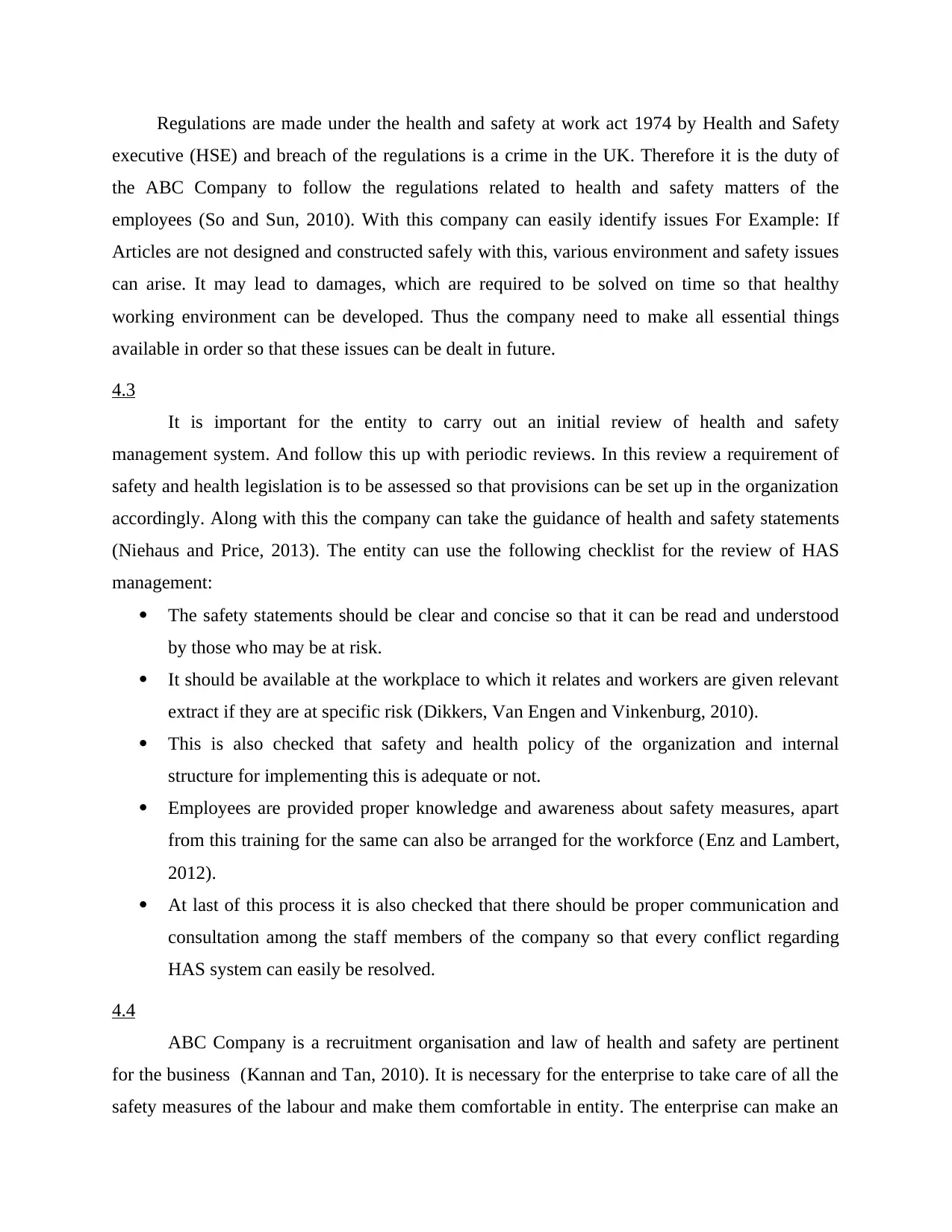
Regulations are made under the health and safety at work act 1974 by Health and Safety
executive (HSE) and breach of the regulations is a crime in the UK. Therefore it is the duty of
the ABC Company to follow the regulations related to health and safety matters of the
employees (So and Sun, 2010). With this company can easily identify issues For Example: If
Articles are not designed and constructed safely with this, various environment and safety issues
can arise. It may lead to damages, which are required to be solved on time so that healthy
working environment can be developed. Thus the company need to make all essential things
available in order so that these issues can be dealt in future.
4.3
It is important for the entity to carry out an initial review of health and safety
management system. And follow this up with periodic reviews. In this review a requirement of
safety and health legislation is to be assessed so that provisions can be set up in the organization
accordingly. Along with this the company can take the guidance of health and safety statements
(Niehaus and Price, 2013). The entity can use the following checklist for the review of HAS
management:
The safety statements should be clear and concise so that it can be read and understood
by those who may be at risk.
It should be available at the workplace to which it relates and workers are given relevant
extract if they are at specific risk (Dikkers, Van Engen and Vinkenburg, 2010).
This is also checked that safety and health policy of the organization and internal
structure for implementing this is adequate or not.
Employees are provided proper knowledge and awareness about safety measures, apart
from this training for the same can also be arranged for the workforce (Enz and Lambert,
2012).
At last of this process it is also checked that there should be proper communication and
consultation among the staff members of the company so that every conflict regarding
HAS system can easily be resolved.
4.4
ABC Company is a recruitment organisation and law of health and safety are pertinent
for the business (Kannan and Tan, 2010). It is necessary for the enterprise to take care of all the
safety measures of the labour and make them comfortable in entity. The enterprise can make an
executive (HSE) and breach of the regulations is a crime in the UK. Therefore it is the duty of
the ABC Company to follow the regulations related to health and safety matters of the
employees (So and Sun, 2010). With this company can easily identify issues For Example: If
Articles are not designed and constructed safely with this, various environment and safety issues
can arise. It may lead to damages, which are required to be solved on time so that healthy
working environment can be developed. Thus the company need to make all essential things
available in order so that these issues can be dealt in future.
4.3
It is important for the entity to carry out an initial review of health and safety
management system. And follow this up with periodic reviews. In this review a requirement of
safety and health legislation is to be assessed so that provisions can be set up in the organization
accordingly. Along with this the company can take the guidance of health and safety statements
(Niehaus and Price, 2013). The entity can use the following checklist for the review of HAS
management:
The safety statements should be clear and concise so that it can be read and understood
by those who may be at risk.
It should be available at the workplace to which it relates and workers are given relevant
extract if they are at specific risk (Dikkers, Van Engen and Vinkenburg, 2010).
This is also checked that safety and health policy of the organization and internal
structure for implementing this is adequate or not.
Employees are provided proper knowledge and awareness about safety measures, apart
from this training for the same can also be arranged for the workforce (Enz and Lambert,
2012).
At last of this process it is also checked that there should be proper communication and
consultation among the staff members of the company so that every conflict regarding
HAS system can easily be resolved.
4.4
ABC Company is a recruitment organisation and law of health and safety are pertinent
for the business (Kannan and Tan, 2010). It is necessary for the enterprise to take care of all the
safety measures of the labour and make them comfortable in entity. The enterprise can make an
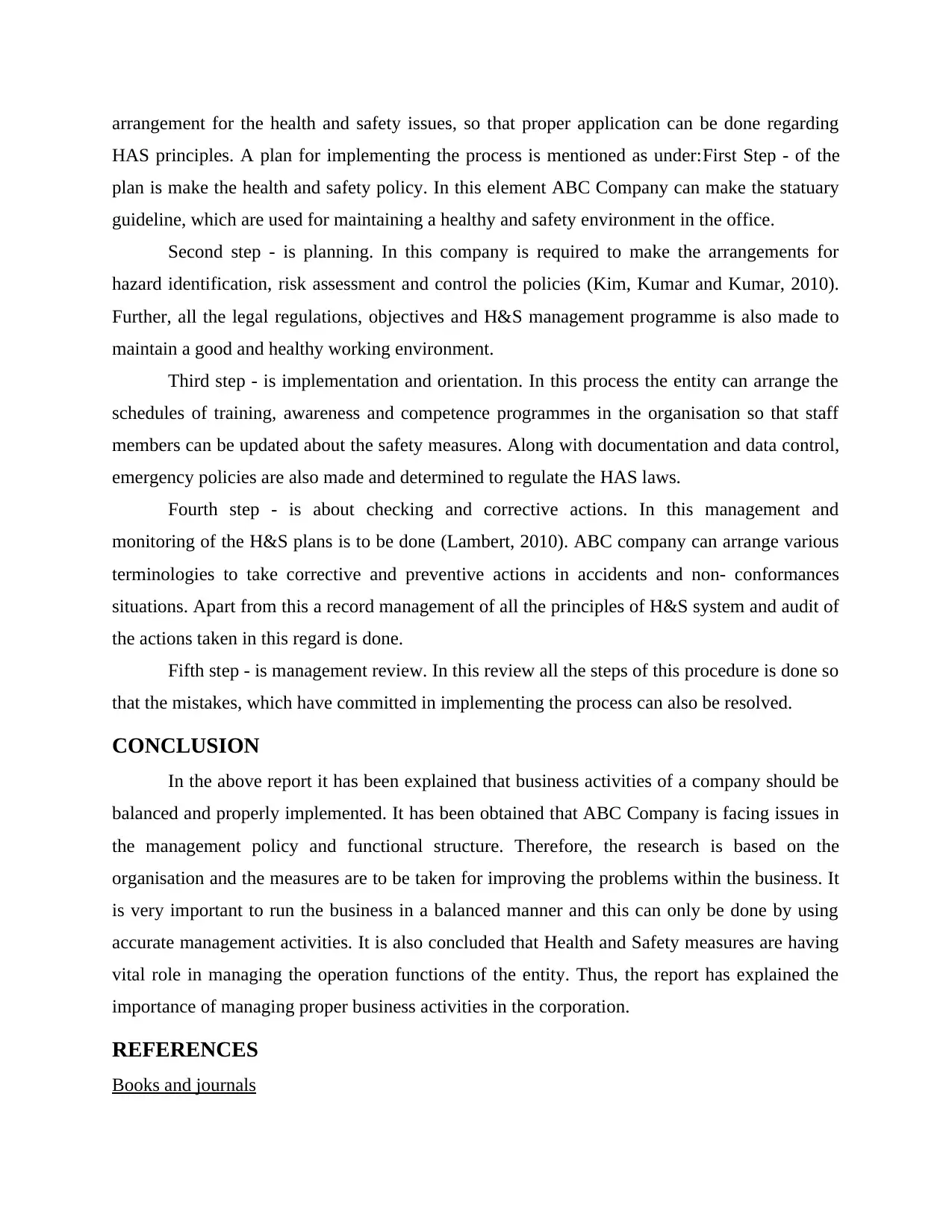
arrangement for the health and safety issues, so that proper application can be done regarding
HAS principles. A plan for implementing the process is mentioned as under:First Step - of the
plan is make the health and safety policy. In this element ABC Company can make the statuary
guideline, which are used for maintaining a healthy and safety environment in the office.
Second step - is planning. In this company is required to make the arrangements for
hazard identification, risk assessment and control the policies (Kim, Kumar and Kumar, 2010).
Further, all the legal regulations, objectives and H&S management programme is also made to
maintain a good and healthy working environment.
Third step - is implementation and orientation. In this process the entity can arrange the
schedules of training, awareness and competence programmes in the organisation so that staff
members can be updated about the safety measures. Along with documentation and data control,
emergency policies are also made and determined to regulate the HAS laws.
Fourth step - is about checking and corrective actions. In this management and
monitoring of the H&S plans is to be done (Lambert, 2010). ABC company can arrange various
terminologies to take corrective and preventive actions in accidents and non- conformances
situations. Apart from this a record management of all the principles of H&S system and audit of
the actions taken in this regard is done.
Fifth step - is management review. In this review all the steps of this procedure is done so
that the mistakes, which have committed in implementing the process can also be resolved.
CONCLUSION
In the above report it has been explained that business activities of a company should be
balanced and properly implemented. It has been obtained that ABC Company is facing issues in
the management policy and functional structure. Therefore, the research is based on the
organisation and the measures are to be taken for improving the problems within the business. It
is very important to run the business in a balanced manner and this can only be done by using
accurate management activities. It is also concluded that Health and Safety measures are having
vital role in managing the operation functions of the entity. Thus, the report has explained the
importance of managing proper business activities in the corporation.
REFERENCES
Books and journals
HAS principles. A plan for implementing the process is mentioned as under:First Step - of the
plan is make the health and safety policy. In this element ABC Company can make the statuary
guideline, which are used for maintaining a healthy and safety environment in the office.
Second step - is planning. In this company is required to make the arrangements for
hazard identification, risk assessment and control the policies (Kim, Kumar and Kumar, 2010).
Further, all the legal regulations, objectives and H&S management programme is also made to
maintain a good and healthy working environment.
Third step - is implementation and orientation. In this process the entity can arrange the
schedules of training, awareness and competence programmes in the organisation so that staff
members can be updated about the safety measures. Along with documentation and data control,
emergency policies are also made and determined to regulate the HAS laws.
Fourth step - is about checking and corrective actions. In this management and
monitoring of the H&S plans is to be done (Lambert, 2010). ABC company can arrange various
terminologies to take corrective and preventive actions in accidents and non- conformances
situations. Apart from this a record management of all the principles of H&S system and audit of
the actions taken in this regard is done.
Fifth step - is management review. In this review all the steps of this procedure is done so
that the mistakes, which have committed in implementing the process can also be resolved.
CONCLUSION
In the above report it has been explained that business activities of a company should be
balanced and properly implemented. It has been obtained that ABC Company is facing issues in
the management policy and functional structure. Therefore, the research is based on the
organisation and the measures are to be taken for improving the problems within the business. It
is very important to run the business in a balanced manner and this can only be done by using
accurate management activities. It is also concluded that Health and Safety measures are having
vital role in managing the operation functions of the entity. Thus, the report has explained the
importance of managing proper business activities in the corporation.
REFERENCES
Books and journals
Secure Best Marks with AI Grader
Need help grading? Try our AI Grader for instant feedback on your assignments.
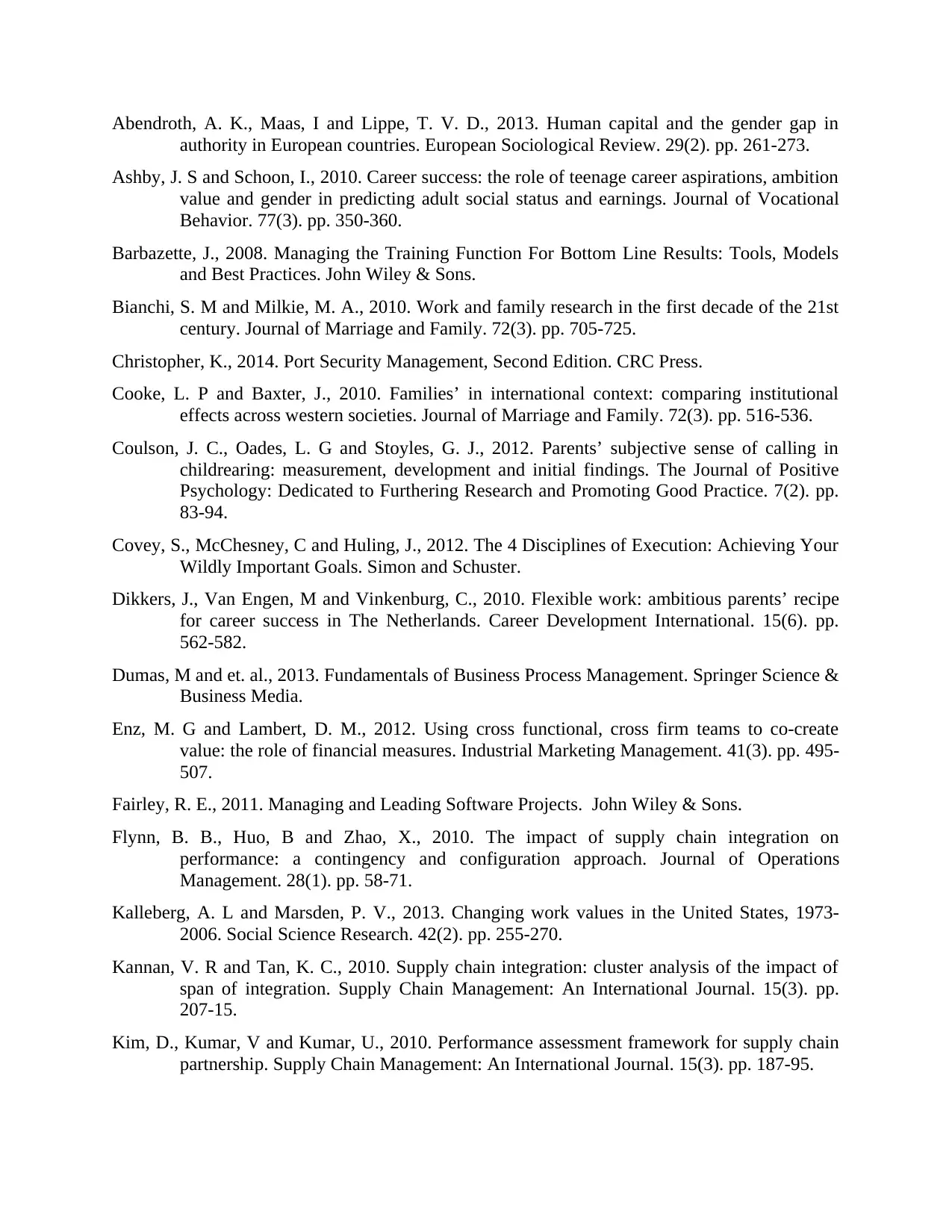
Abendroth, A. K., Maas, I and Lippe, T. V. D., 2013. Human capital and the gender gap in
authority in European countries. European Sociological Review. 29(2). pp. 261-273.
Ashby, J. S and Schoon, I., 2010. Career success: the role of teenage career aspirations, ambition
value and gender in predicting adult social status and earnings. Journal of Vocational
Behavior. 77(3). pp. 350-360.
Barbazette, J., 2008. Managing the Training Function For Bottom Line Results: Tools, Models
and Best Practices. John Wiley & Sons.
Bianchi, S. M and Milkie, M. A., 2010. Work and family research in the first decade of the 21st
century. Journal of Marriage and Family. 72(3). pp. 705-725.
Christopher, K., 2014. Port Security Management, Second Edition. CRC Press.
Cooke, L. P and Baxter, J., 2010. Families’ in international context: comparing institutional
effects across western societies. Journal of Marriage and Family. 72(3). pp. 516-536.
Coulson, J. C., Oades, L. G and Stoyles, G. J., 2012. Parents’ subjective sense of calling in
childrearing: measurement, development and initial findings. The Journal of Positive
Psychology: Dedicated to Furthering Research and Promoting Good Practice. 7(2). pp.
83-94.
Covey, S., McChesney, C and Huling, J., 2012. The 4 Disciplines of Execution: Achieving Your
Wildly Important Goals. Simon and Schuster.
Dikkers, J., Van Engen, M and Vinkenburg, C., 2010. Flexible work: ambitious parents’ recipe
for career success in The Netherlands. Career Development International. 15(6). pp.
562-582.
Dumas, M and et. al., 2013. Fundamentals of Business Process Management. Springer Science &
Business Media.
Enz, M. G and Lambert, D. M., 2012. Using cross functional, cross firm teams to co‐create
value: the role of financial measures. Industrial Marketing Management. 41(3). pp. 495‐
507.
Fairley, R. E., 2011. Managing and Leading Software Projects. John Wiley & Sons.
Flynn, B. B., Huo, B and Zhao, X., 2010. The impact of supply chain integration on
performance: a contingency and configuration approach. Journal of Operations
Management. 28(1). pp. 58‐71.
Kalleberg, A. L and Marsden, P. V., 2013. Changing work values in the United States, 1973-
2006. Social Science Research. 42(2). pp. 255-270.
Kannan, V. R and Tan, K. C., 2010. Supply chain integration: cluster analysis of the impact of
span of integration. Supply Chain Management: An International Journal. 15(3). pp.
207‐15.
Kim, D., Kumar, V and Kumar, U., 2010. Performance assessment framework for supply chain
partnership. Supply Chain Management: An International Journal. 15(3). pp. 187‐95.
authority in European countries. European Sociological Review. 29(2). pp. 261-273.
Ashby, J. S and Schoon, I., 2010. Career success: the role of teenage career aspirations, ambition
value and gender in predicting adult social status and earnings. Journal of Vocational
Behavior. 77(3). pp. 350-360.
Barbazette, J., 2008. Managing the Training Function For Bottom Line Results: Tools, Models
and Best Practices. John Wiley & Sons.
Bianchi, S. M and Milkie, M. A., 2010. Work and family research in the first decade of the 21st
century. Journal of Marriage and Family. 72(3). pp. 705-725.
Christopher, K., 2014. Port Security Management, Second Edition. CRC Press.
Cooke, L. P and Baxter, J., 2010. Families’ in international context: comparing institutional
effects across western societies. Journal of Marriage and Family. 72(3). pp. 516-536.
Coulson, J. C., Oades, L. G and Stoyles, G. J., 2012. Parents’ subjective sense of calling in
childrearing: measurement, development and initial findings. The Journal of Positive
Psychology: Dedicated to Furthering Research and Promoting Good Practice. 7(2). pp.
83-94.
Covey, S., McChesney, C and Huling, J., 2012. The 4 Disciplines of Execution: Achieving Your
Wildly Important Goals. Simon and Schuster.
Dikkers, J., Van Engen, M and Vinkenburg, C., 2010. Flexible work: ambitious parents’ recipe
for career success in The Netherlands. Career Development International. 15(6). pp.
562-582.
Dumas, M and et. al., 2013. Fundamentals of Business Process Management. Springer Science &
Business Media.
Enz, M. G and Lambert, D. M., 2012. Using cross functional, cross firm teams to co‐create
value: the role of financial measures. Industrial Marketing Management. 41(3). pp. 495‐
507.
Fairley, R. E., 2011. Managing and Leading Software Projects. John Wiley & Sons.
Flynn, B. B., Huo, B and Zhao, X., 2010. The impact of supply chain integration on
performance: a contingency and configuration approach. Journal of Operations
Management. 28(1). pp. 58‐71.
Kalleberg, A. L and Marsden, P. V., 2013. Changing work values in the United States, 1973-
2006. Social Science Research. 42(2). pp. 255-270.
Kannan, V. R and Tan, K. C., 2010. Supply chain integration: cluster analysis of the impact of
span of integration. Supply Chain Management: An International Journal. 15(3). pp.
207‐15.
Kim, D., Kumar, V and Kumar, U., 2010. Performance assessment framework for supply chain
partnership. Supply Chain Management: An International Journal. 15(3). pp. 187‐95.
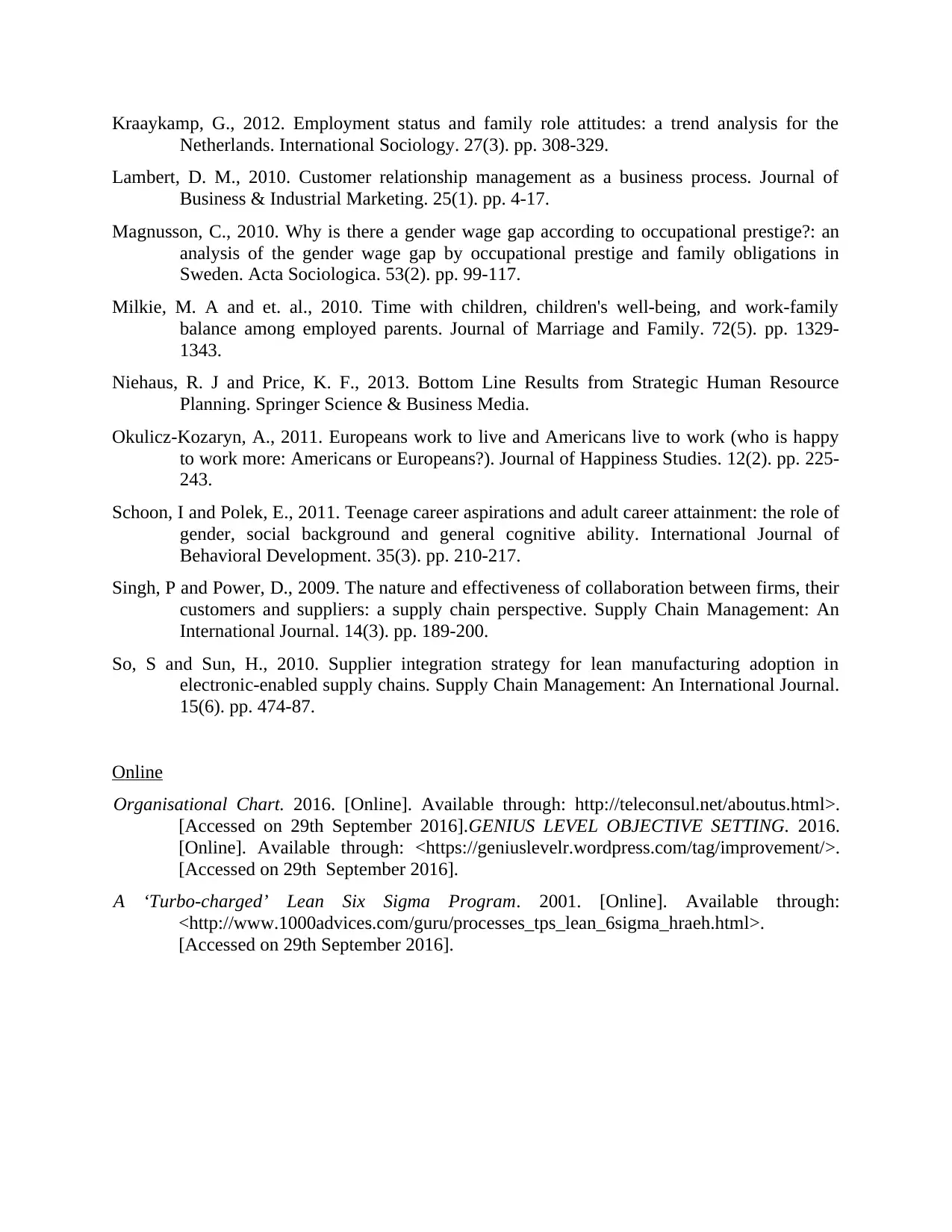
Kraaykamp, G., 2012. Employment status and family role attitudes: a trend analysis for the
Netherlands. International Sociology. 27(3). pp. 308-329.
Lambert, D. M., 2010. Customer relationship management as a business process. Journal of
Business & Industrial Marketing. 25(1). pp. 4‐17.
Magnusson, C., 2010. Why is there a gender wage gap according to occupational prestige?: an
analysis of the gender wage gap by occupational prestige and family obligations in
Sweden. Acta Sociologica. 53(2). pp. 99-117.
Milkie, M. A and et. al., 2010. Time with children, children's well-being, and work-family
balance among employed parents. Journal of Marriage and Family. 72(5). pp. 1329-
1343.
Niehaus, R. J and Price, K. F., 2013. Bottom Line Results from Strategic Human Resource
Planning. Springer Science & Business Media.
Okulicz-Kozaryn, A., 2011. Europeans work to live and Americans live to work (who is happy
to work more: Americans or Europeans?). Journal of Happiness Studies. 12(2). pp. 225-
243.
Schoon, I and Polek, E., 2011. Teenage career aspirations and adult career attainment: the role of
gender, social background and general cognitive ability. International Journal of
Behavioral Development. 35(3). pp. 210-217.
Singh, P and Power, D., 2009. The nature and effectiveness of collaboration between firms, their
customers and suppliers: a supply chain perspective. Supply Chain Management: An
International Journal. 14(3). pp. 189‐200.
So, S and Sun, H., 2010. Supplier integration strategy for lean manufacturing adoption in
electronic‐enabled supply chains. Supply Chain Management: An International Journal.
15(6). pp. 474‐87.
Online
Organisational Chart. 2016. [Online]. Available through: http://teleconsul.net/aboutus.html>.
[Accessed on 29th September 2016].GENIUS LEVEL OBJECTIVE SETTING. 2016.
[Online]. Available through: <https://geniuslevelr.wordpress.com/tag/improvement/>.
[Accessed on 29th September 2016].
A ‘Turbo-charged’ Lean Six Sigma Program. 2001. [Online]. Available through:
<http://www.1000advices.com/guru/processes_tps_lean_6sigma_hraeh.html>.
[Accessed on 29th September 2016].
Netherlands. International Sociology. 27(3). pp. 308-329.
Lambert, D. M., 2010. Customer relationship management as a business process. Journal of
Business & Industrial Marketing. 25(1). pp. 4‐17.
Magnusson, C., 2010. Why is there a gender wage gap according to occupational prestige?: an
analysis of the gender wage gap by occupational prestige and family obligations in
Sweden. Acta Sociologica. 53(2). pp. 99-117.
Milkie, M. A and et. al., 2010. Time with children, children's well-being, and work-family
balance among employed parents. Journal of Marriage and Family. 72(5). pp. 1329-
1343.
Niehaus, R. J and Price, K. F., 2013. Bottom Line Results from Strategic Human Resource
Planning. Springer Science & Business Media.
Okulicz-Kozaryn, A., 2011. Europeans work to live and Americans live to work (who is happy
to work more: Americans or Europeans?). Journal of Happiness Studies. 12(2). pp. 225-
243.
Schoon, I and Polek, E., 2011. Teenage career aspirations and adult career attainment: the role of
gender, social background and general cognitive ability. International Journal of
Behavioral Development. 35(3). pp. 210-217.
Singh, P and Power, D., 2009. The nature and effectiveness of collaboration between firms, their
customers and suppliers: a supply chain perspective. Supply Chain Management: An
International Journal. 14(3). pp. 189‐200.
So, S and Sun, H., 2010. Supplier integration strategy for lean manufacturing adoption in
electronic‐enabled supply chains. Supply Chain Management: An International Journal.
15(6). pp. 474‐87.
Online
Organisational Chart. 2016. [Online]. Available through: http://teleconsul.net/aboutus.html>.
[Accessed on 29th September 2016].GENIUS LEVEL OBJECTIVE SETTING. 2016.
[Online]. Available through: <https://geniuslevelr.wordpress.com/tag/improvement/>.
[Accessed on 29th September 2016].
A ‘Turbo-charged’ Lean Six Sigma Program. 2001. [Online]. Available through:
<http://www.1000advices.com/guru/processes_tps_lean_6sigma_hraeh.html>.
[Accessed on 29th September 2016].
1 out of 18
Related Documents
Your All-in-One AI-Powered Toolkit for Academic Success.
+13062052269
info@desklib.com
Available 24*7 on WhatsApp / Email
![[object Object]](/_next/static/media/star-bottom.7253800d.svg)
Unlock your academic potential
© 2024 | Zucol Services PVT LTD | All rights reserved.





